
S&P 500
A new all time high for the S&P500 was expected as likely this week. While price has not managed to make a new all time high, Friday’s high is just 0.59 points short. Strength in upwards movement fits the Elliott wave count.
Summary: Upwards movement may continue here to new all time highs soon. The next target is at 3,120. New all time highs from the AD line this week strongly support a bullish outlook.
For the very short term, a new low below 3,001.94 would indicate a short-term pull back. The target would be about 2,962.
A new low below 2,822.12 would add confidence to an alternate. Expect price at that stage to keep falling to 2,578 – 2,476 to find support at the lower edge of the large teal channel on weekly and daily charts. This alternate has a very low probability and would be invalidated with a new all time high.
The biggest picture, Grand Super Cycle analysis, is here.
Monthly charts were last published here. There are two further alternate monthly charts here.
ELLIOTT WAVE COUNTS
The two weekly Elliott wave counts below will be labelled First and Second. They may be about of even probability. When the fifth wave currently unfolding on weekly charts may be complete, then these two wave counts will diverge on the severity of the expected following bear market. To see an illustration of this future divergence monthly charts should be viewed.
FIRST WAVE COUNT
MAIN WEEKLY CHART
The basic Elliott wave structure consists of a five wave structure up followed by a three wave structure down (for a bull market). This wave count sees the bull market beginning in March 2009 as an incomplete five wave impulse and now within the last fifth wave, which is labelled cycle wave V. This impulse is best viewed on monthly charts. The weekly chart focusses on the end of it.
Elliott wave is fractal. This fifth wave labelled cycle wave V may end a larger fifth wave labelled Super Cycle wave (V), which may end a larger first wave labelled Grand Super Cycle wave I.
The teal Elliott channel is drawn using Elliott’s first technique about the impulse of Super Cycle wave (V). Draw the first trend line from the end of cycle wave I (off to the left of the chart, the weekly candlestick beginning 30th November 2014) to the end of cycle wave III, then place a parallel copy on the end of cycle wave II. This channel perfectly shows where cycle wave IV ended at support. The strongest portion of cycle wave III, the end of primary wave 3, overshoots the upper edge of the channel. This is a typical look for a third wave and suggests the channel is drawn correctly and the way the impulse is counted is correct.
Within Super Cycle wave (V), cycle wave III is shorter than cycle wave I. A core Elliott wave rule states that a third wave may never be the shortest. For this rule to be met in this instance, cycle wave V may not be longer in length than cycle wave III. This limit is at 3,477.39.
Cycle wave V may subdivide either as an impulse or an ending diagonal. Impulses are much more common. This main wave count expects that cycle wave V may be unfolding as an impulse.
The daily chart below will focus on movement from the end of intermediate wave (1) within primary wave 3.
In historic analysis, two further monthly charts have been published that do not have a limit to upwards movement and are more bullish than this wave count. Members are encouraged to consider those possibilities (links below summary) alongside the wave counts presented on a daily and weekly basis.
Within cycle wave V, primary waves 1 and 2 may be complete. Within primary wave 3, intermediate wave (2) may not move beyond the start of intermediate wave (1) below 2,728.81.
MAIN DAILY CHART
Primary wave 3 may have begun.
All of primary wave 3, intermediate wave (3) and minor wave 3 may only subdivide as impulses. Within each impulse, its second wave correction may not move beyond the start of its first wave.
Minor wave 2 may not move beyond the start of minor wave 1 below 2,822.12. It is still possible that minor wave 2 may continue lower as a double zigzag. The invalidation point is left the same to allow for this possibility. If price makes a new all time high in coming days, then the invalidation point will be moved upwards to the end of minor wave 2 at 2,855.96.
Minute wave i looks like a completed five wave impulse at the daily chart level.
Intermediate wave (3) must move far enough above the end of intermediate wave (1) to then allow intermediate wave (4) to unfold and remain above intermediate wave (1) price territory.
ALTERNATE WEEKLY CHART
Cycle wave V may be subdividing as an ending diagonal. Within ending diagonals, all sub-waves must subdivide as zigzags. Primary wave 1 may be over at the last all time high as a zigzag.
Primary wave 2 must complete lower as a zigzag.
The second and fourth waves within diagonals are usually very deep, commonly between 0.81 to 0.66 the depth of the prior wave. This gives a target zone for primary wave 2.
Primary wave 2 may end if it comes down to find support at the lower edge of the teal channel, which is copied over from monthly and weekly charts. This trend line should provide final support for a deeper pullback.
Primary wave 2 may not move beyond the start of primary wave 1 below 2,346.58.
Within primary wave 2, intermediate wave (B) may not move beyond the start of intermediate wave (A) above 3.027.98. A new all time high would invalidate this wave count.
This alternate wave count is provided only for those members who wish to follow a more bearish wave count due to their own personal analysis. It is my judgement that this wave count has a very low probability.
SECOND WAVE COUNT
WEEKLY CHART
This weekly chart is almost identical to the first weekly chart, with the sole exception being the degree of labelling.
This weekly chart moves the degree of labelling for the impulse beginning in March 2009 all down one degree. This difference is best viewed on monthly charts.
The impulse is still viewed as nearing an end; a fifth wave is still seen as needing to complete higher. This wave count labels it primary wave 5.
Primary wave 5 may be subdividing as either an impulse or ending diagonal, in the same way that cycle wave V is seen for the first weekly chart.
TECHNICAL ANALYSIS
WEEKLY CHART
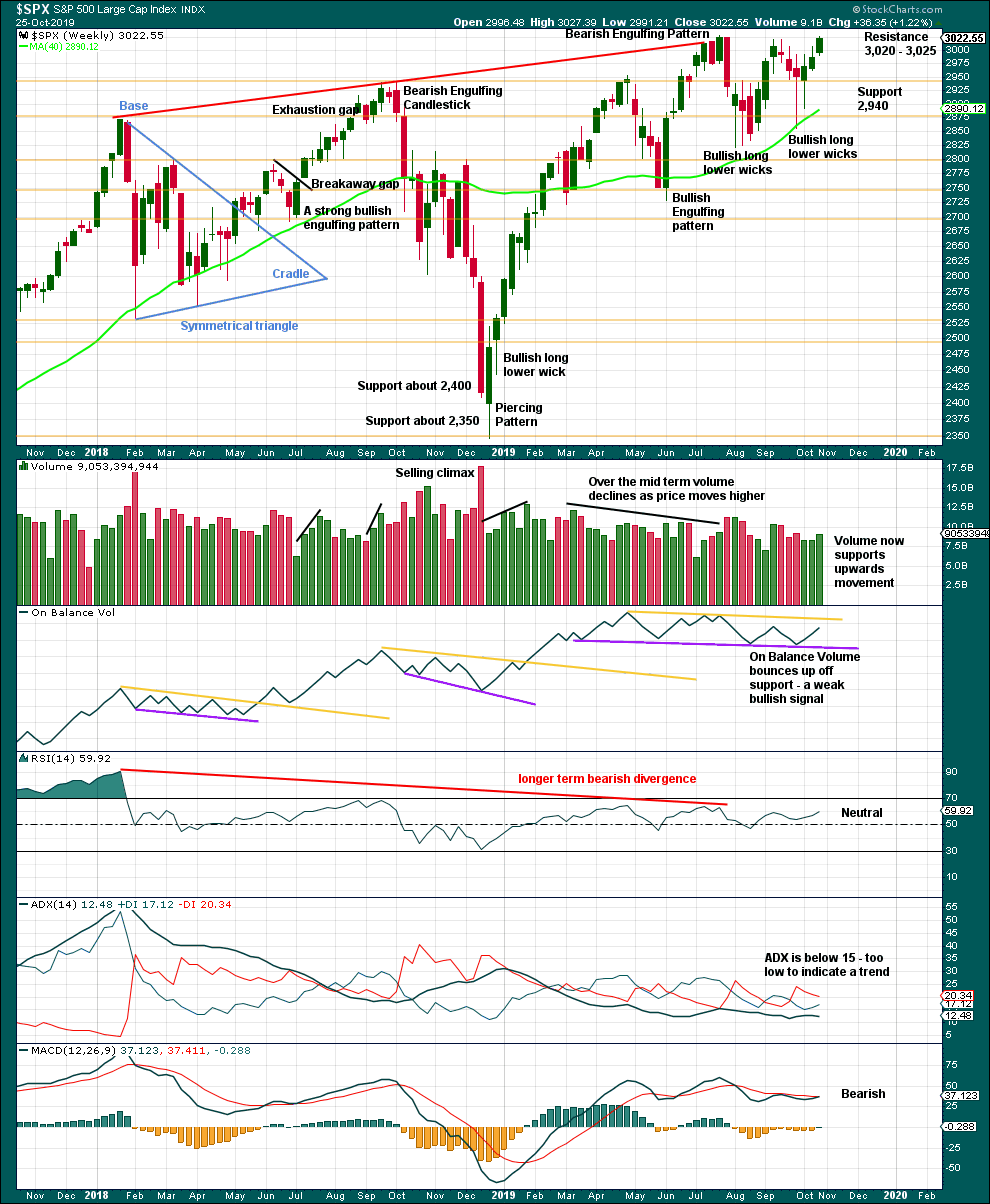
Click chart to enlarge. Chart courtesy of StockCharts.com.
There is still a series of higher highs (with the exception of the last high) and higher lows from the low in December 2018. This is the basic definition of an upwards trend. For that view to shift then a lower low below 2,822.12 would need to be seen.
This week looks more clearly bullish with some support from volume. There is strong resistance in this area, which is not yet overcome.
DAILY CHART
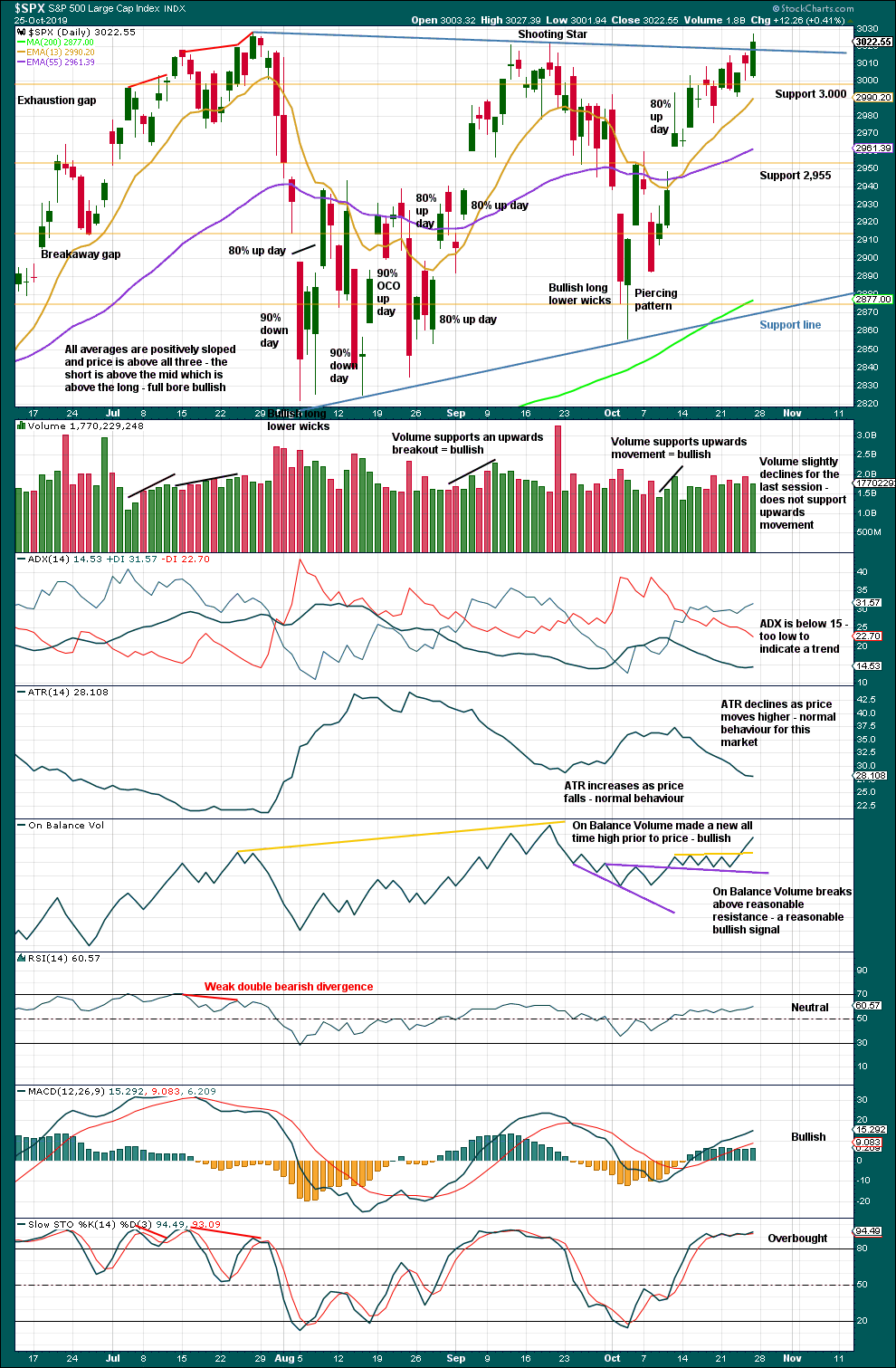
Click chart to enlarge. Chart courtesy of StockCharts.com.
There is now a series of higher highs and higher lows since the 5th of August. Strength in 90% up days and back to back 80% up days off lows indicate the lows may still be sustainable.
The bullish signal from On Balance Volume is reasonable because the resistance line is clearly breached, had four prior tests and was horizontal. This supports the Elliott wave count.
On Friday price has closed above the upper resistance line, but it has not done so with support from volume. Normally, the upwards breakout would be considered suspicious. However, this market has been rising for years now on light and declining volume at all time frames, including monthly, and a sustainable rise in price in current market conditions does not appear to always require rising volume.
If ADX reaches 15, it would indicate an upwards trend in a very early stage. That would be the strongest signal ADX can give.
BREADTH – AD LINE
WEEKLY CHART
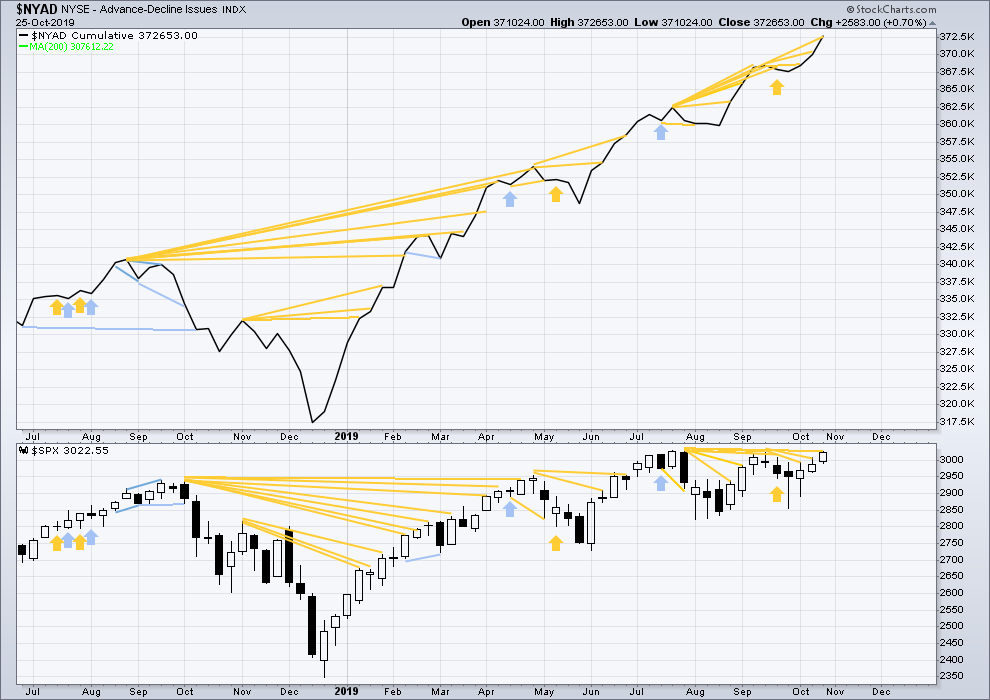
Click chart to enlarge. Chart courtesy of StockCharts.com. So that colour blind members are included, bearish signals
will be noted with blue and bullish signals with yellow.
Bear markets from the Great Depression and onwards have been preceded by an average minimum of 4 months divergence between price and the AD line with only two exceptions in 1946 and 1976. With the AD line making new all time highs again this week, the end of this bull market and the start of a new bear market is very likely a minimum of 4 months away, which is end February 2020.
In all bear markets in the last 90 years there is some positive correlation (0.6022) between the length of bearish divergence and the depth of the following bear market. No to little divergence is correlated with more shallow bear markets. Longer divergence is correlated with deeper bear markets.
If a bear market does develop here, it comes after no bearish divergence. It would therefore more likely be shallow.
This week only large caps have made a new high above the prior swing high in mid September. Small and mid caps have not. This current rise is driven mostly by larger caps, which is a feature more typical of an aged bull market.
The new all time high from the AD line this week is again a very bullish signal. This strongly supports the main Elliott wave count.
DAILY CHART
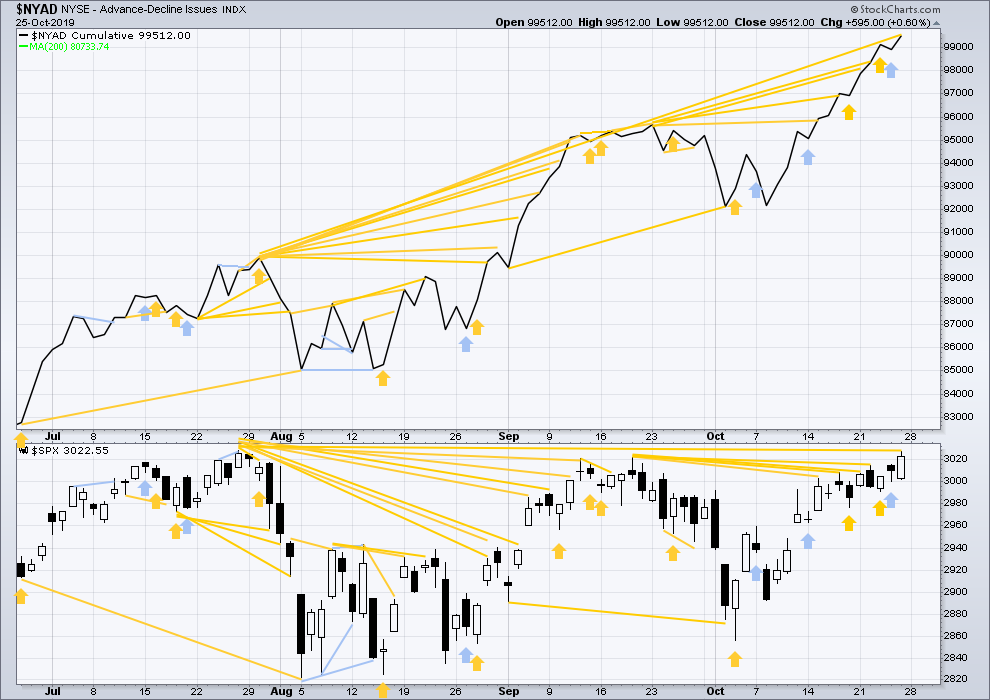
Click chart to enlarge. Chart courtesy of StockCharts.com. So that colour blind members are included, bearish signals
will be noted with blue and bullish signals with yellow.
Breadth should be read as a leading indicator.
The AD line makes yet another new all time high today. This divergence is bullish and strong. It is given reasonable weight in this analysis.
Another new all time high from the AD line at the daily chart level is very bullish.
VOLATILITY – INVERTED VIX CHART
WEEKLY CHART

Click chart to enlarge. Chart courtesy of StockCharts.com. So that colour blind members are included, bearish signals
will be noted with blue and bullish signals with yellow.
The all time high for inverted VIX (which is the same as the low for VIX) was on 30th October 2017. There is now almost two years of bearish divergence between price and inverted VIX.
The rise in price is not coming with a normal corresponding decline in VIX; VIX remains elevated. This long-term divergence is bearish and may yet develop further as the bull market matures.
This divergence may be an early warning, a part of the process of a top developing that may take years. It may not be useful in timing a trend change.
This week both price and inverted VIX have moved higher. Both have made new short-term swing highs. There is no new divergence.
DAILY CHART
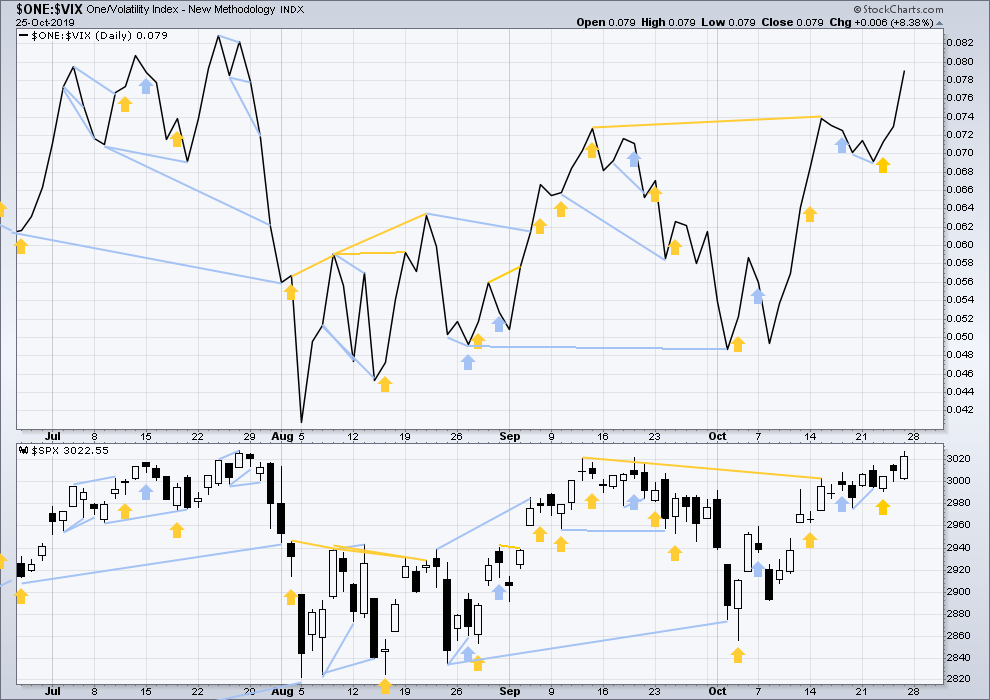
Click chart to enlarge. Chart courtesy of StockCharts.com. So that colour blind members are included, bearish signals
will be noted with blue and bullish signals with yellow.
On Friday both price and inverted VIX have moved higher. Both have made new short and mid-term swing highs. Neither have made new longer term all time highs. There is no new short-term divergence.
DOW THEORY
Dow Theory confirmed a bear market in December 2018. This does not necessarily mean a bear market at Grand Super Cycle degree though; Dow Theory makes no comment on Elliott wave counts. On the 25th of August 2015 Dow Theory also confirmed a bear market. The Elliott wave count sees that as part of cycle wave II. After Dow Theory confirmation of a bear market in August 2015, price went on to make new all time highs and the bull market continued.
DJIA: 23,344.52 – a close on the 19th of December at 23,284.97 confirms a bear market.
DJT: 9,806.79 – price has closed below this point on the 13th of December.
S&P500: 2,532.69 – a close on the 19th of December at 2,506.96 provides support to a bear market conclusion.
Nasdaq: 6,630.67 – a close on the 19th of December at 6,618.86 provides support to a bear market conclusion.
With all the indices having moved higher following a Dow Theory bear market confirmation, Dow Theory would confirm a bull market if the following highs are made:
DJIA: 26,951.81 – a close above this point has been made on the 3rd of July 2019.
DJT: 11,623.58 – to date DJT has failed to confirm an ongoing bull market.
S&P500: 2,940.91 – a close above this point was made on the 29th of April 2019.
Nasdaq: 8,133.30 – a close above this point was made on the 26th of April 2019.
GOLD
Price remains range bound at the end of the week. All three Elliott wave counts remain valid, but volume and price now suggest the main and alternate bearish counts should be swapped over.
Summary: A new high above 1,515.58 has given a little confidence to a more bullish outlook at least for the short term. The target is at 1,567, 1,652 or 1,693.
For the bigger picture, the bearish Elliott wave count expects a new downwards trend to last one to several years may begin after one more high. The alternate bearish wave count looks at the possibility that a major high is already in. Confidence in this view may be had if price makes a new low by any amount at any time frame below 1,346.45.
The bullish Elliott wave count expects a primary degree fourth wave has completed and the upwards trend has resumed.
Grand SuperCycle analysis is here.
Monthly charts were last published here.
BEARISH ELLIOTT WAVE COUNT
WEEKLY CHART
It is possible that Super Cycle wave (b) is nearly complete as a double zigzag.
The first zigzag in the double is labelled cycle wave w. The double is joined by a three in the opposite direction, a triangle labelled cycle wave x. The second zigzag in the double is labelled cycle wave y.
The purpose of the second zigzag in a double is to deepen the correction. Cycle wave y has achieved this purpose.
A new low below 1,346.45 would add strong confidence to this wave count. At that stage, the bullish Elliott wave count would be invalidated.
A wide best fit channel is added in light blue. This channel contains all of Super Cycle wave (b) and may provide resistance and support. Copy this channel over to daily charts.
DAILY CHART
This wave count exactly follows the expected pathway for Silver.
It is possible that the double zigzag for Super Cycle wave (b) may be incomplete and may yet require one more high. A target is calculated for primary wave C that expects resistance at the upper edge of the light blue best fit channel to continue.
Within cycle wave y, primary wave A may have been over at the last high. Primary wave B may now be a complete zigzag. Primary wave C may have begun. Within primary wave C, intermediate wave (2) may not move beyond the start of intermediate wave (1) below 1,456.64.
A channel is drawn about cycle wave y using Elliott’s technique for a correction. At this stage, the lower edge of this channel should provide strong support for pullbacks within primary wave C. If this channel is breached by downwards movement, then the probability of this wave count would reduce substantially. At this stage, the lower edge of this channel is showing where support has been found support this week.
It is possible to move the degree of labelling within intermediate wave (B) down one degree; intermediate wave (B) may still continue lower as a double zigzag. Within the double, wave X may be completing. If intermediate wave (B) continues lower, it would still have good proportion to intermediate wave (A). Intermediate wave (B) may not move beyond the start of intermediate wave (A) below 1,266.61.
ALTERNATE DAILY CHART
Cycle wave y may still be a complete zigzag. Within both of primary waves A and C, there is good proportion between intermediate waves (2) and (4). Within both of primary waves A and C, there is good alternation in structure of intermediate waves (2) and (4).
Within cycle wave y, there is no Fibonacci Ratio between primary waves A and C.
Draw a base channel on daily charts about minor waves 1 and 2. Draw the first trend line from the start of minor wave 1 to the end of minor wave 2, then place a parallel copy on the end of minor wave 1. The upper edge of this channel is now fully breached by a daily candlestick that is above and does not touch the upper edge. The probability of this wave count is now reduced, so it is swapped over as an alternate. However, Gold does not always fit neatly within base channels. Occasionally, second wave corrections can be deep and time consuming and can breach base channels. This wave count remains valid.
BULLISH ELLIOTT WAVE COUNT
WEEKLY CHART
This wave count sees the the bear market complete at the last major low for Gold in November 2015.
If Gold is in a new bull market, then it should begin with a five wave structure upwards on the weekly chart. However, the biggest problem with this wave count is the structure labelled cycle wave I because this wave count must see it as a five wave structure, but it looks more like a three wave structure.
Commodities often exhibit swift strong fifth waves that force the fourth wave corrections coming just prior and just after to be more brief and shallow than their counterpart second waves. It is unusual for a commodity to exhibit a quick second wave and a more time consuming fourth wave, and this is how cycle wave I is labelled. This wave count still suffers from this very substantial problem, and for this reason the bearish wave count is still considered because it has a better fit in terms of Elliott wave structure.
Cycle wave II subdivides well as a double combination: zigzag – X – expanded flat.
Cycle wave III may have begun. Within cycle wave III, primary waves 1 and 2 may now be complete. Primary wave 3 has now moved above the end of primary wave 1 meeting a core Elliott wave rule. It has now moved far enough to allow room for primary wave 4 to unfold and remain above primary wave 1 price territory. Primary wave 4 may not move into primary wave 1 price territory below 1,346.45.
Cycle wave III so far for this wave count would have been underway now for 62 weeks. It is beginning to exhibit some support from volume and increasing ATR. This wave count now has some support from classic technical analysis.
The channel drawn about cycle wave III is an adjusted Elliott channel. The lower edge is pulled lower.
Add the wide best fit channel to weekly and daily charts.
DAILY CHART
Primary wave 4 is possibly complete. The structure now fits as a zigzag. It is possible that primary wave 4 could continue lower as a double zigzag. However, if primary wave 4 did continue lower, it may become longer in duration to primary wave 2. The proportion may not look good. This wave count would look best if primary wave 4 is over as labelled.
Primary wave 2 lasted 43 sessions. Primary wave 4 may have been over in 19 sessions. Gold’s fourth waves are often more brief in duration than its second waves; this part of the wave count has the right look.
Primary wave 4 may not move into primary wave 1 price territory below 1,346.45.
TECHNICAL ANALYSIS
WEEKLY CHART
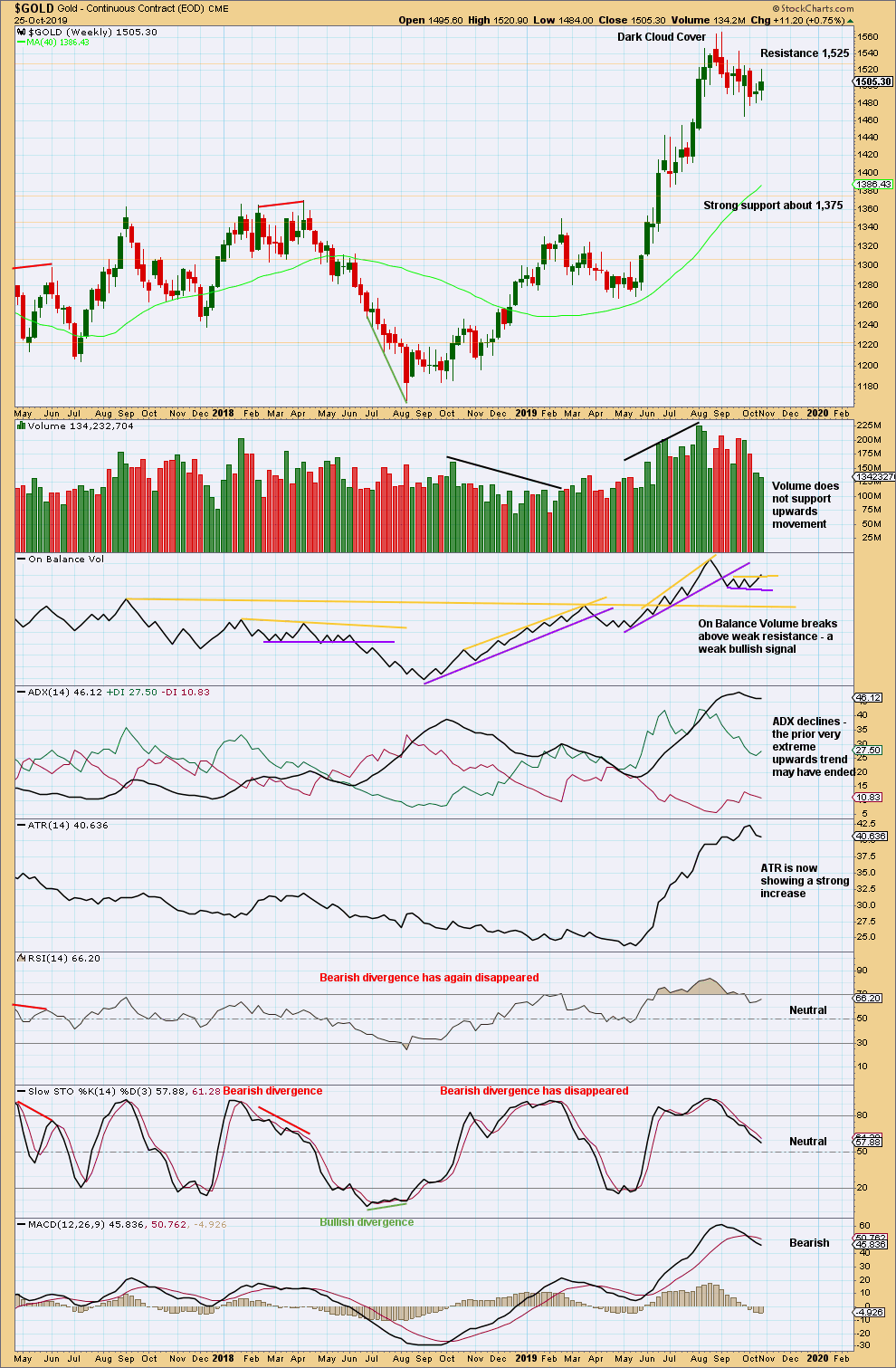
Click chart to enlarge. Chart courtesy of StockCharts.com.
When trends reach very extreme, candlestick reversal patterns should be given weight. The Dark Cloud Cover bearish reversal pattern is given more bearish weight from the long upper wick.
This pullback has brought RSI and Stochastics down from overbought and ADX down from very extreme. It looks like a high may be in place for Gold, but it is also possible that one final high may yet be seen before a major trend change.
This week gives contradictory signals. A decline in volume does not support upwards movement, but On Balance Volume gives a weak bullish signal. The view that a high may be in, or one final high may yet unfold shortly, is unchanged.
DAILY CHART

Click chart to enlarge. Chart courtesy of StockCharts.com.
Since the last high on the 4th of September, there has been a new swing low (on the 30th of September) and now a series of (so far) two lower swing lows and two lower swing highs. In conjunction with a very strong Bearish Engulfing pattern on the 5th of September and the prior upwards trend reaching very extreme, it looks like Gold may have had a trend change.
The pennant pattern no longer looks very likely, but a reasonably small ascending triangle may be unfolding.
From Kirkpatrick and Dhalquist, “Technical Analysis” page 317:
“Upwards breakouts occur 77% of the time, and all breakouts usually happen roughly 61% of the distance (time) from the base to the cradle.”
In this instance that may be in about another seven sessions.
Friday’s session has support from volume, but the very long upper wick is fairly bearish and price has found strong resistance at the upper edge of the triangle pattern.
GDX WEEKLY CHART
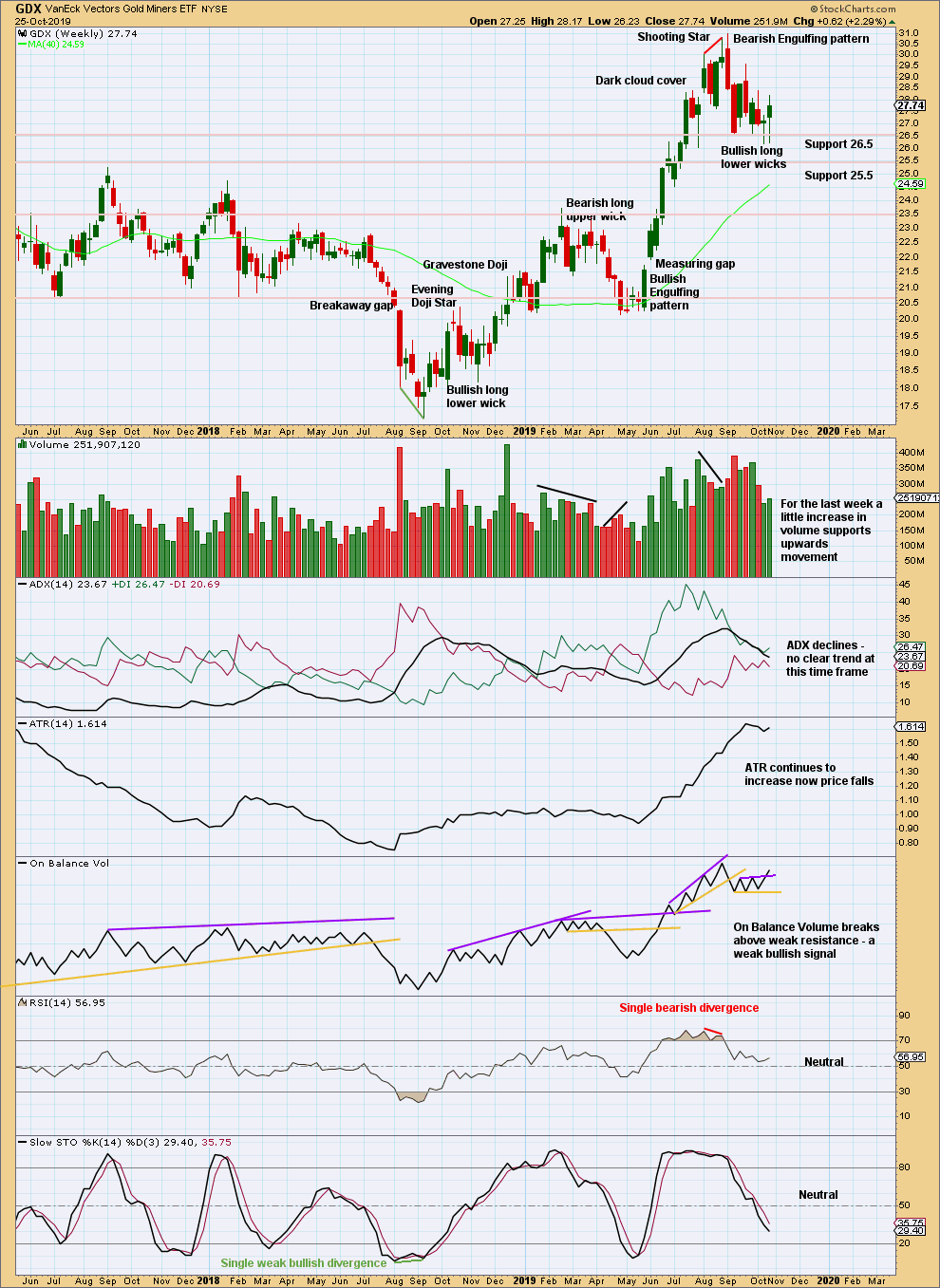
Click chart to enlarge. Chart courtesy of StockCharts.com.
Some increase in volume, a long lower wick, and a weak bullish signal from On Balance Volume suggest more upwards movement for the short term.
GDX DAILY CHART
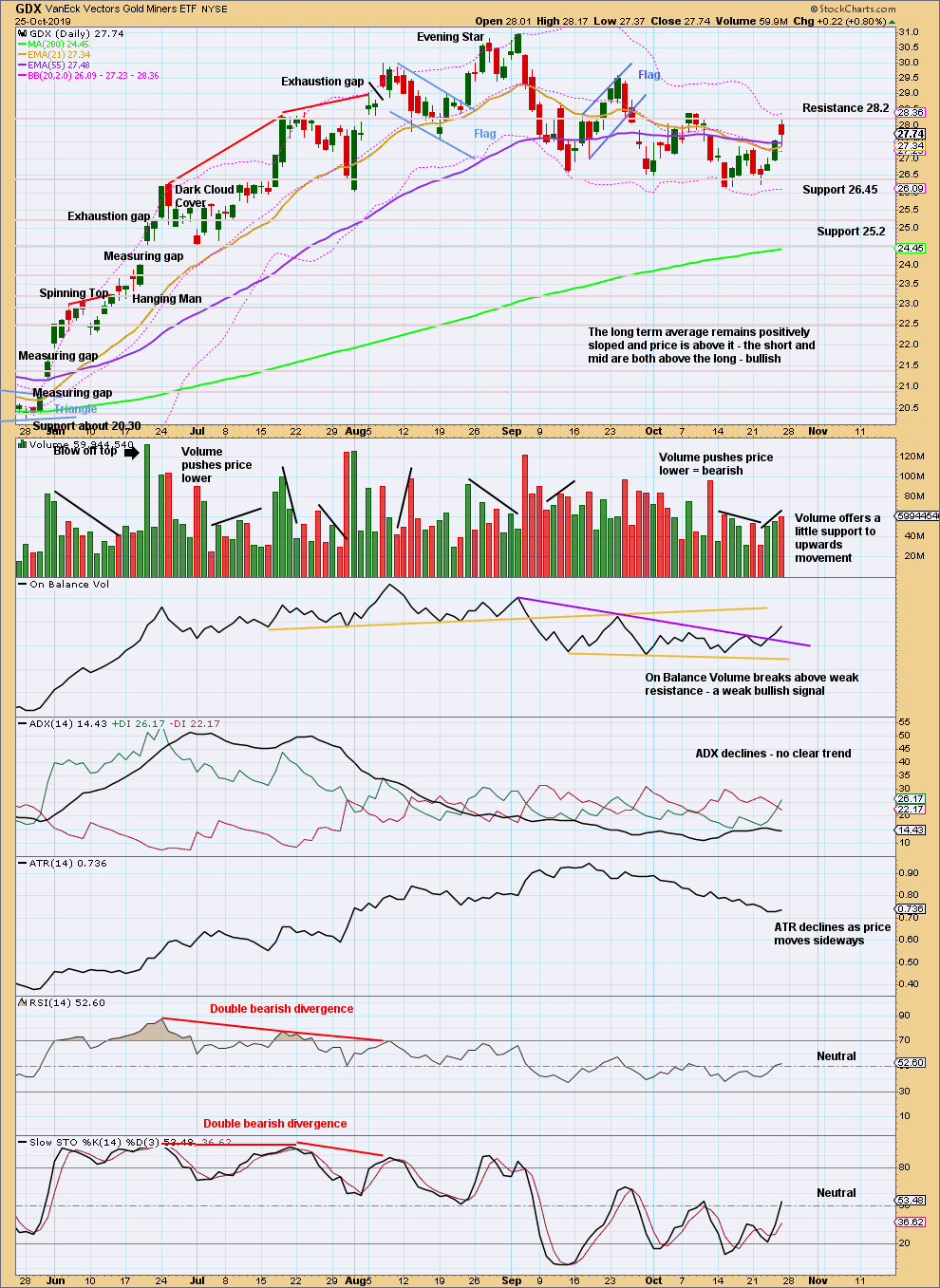
Click chart to enlarge. Chart courtesy of StockCharts.com.
There is now a series of three lower highs and three lower lows from the high on the 4th of September. It still looks like GDX may have had a trend change. This view should remain dominant while the last swing high at 28.38 on the 8th of October remains intact.
For the very short term, GDX is also contradictory: Volume supported upwards movement on Friday, but the candlestick has closed red.
US OIL
Upwards movement was expected for the week for the main Elliott wave count, which is what has happened.
Summary: The bearish wave count looks most likely to follow a triangle pattern here, with an upwards swing to end short of the upper A-C trend line.
The bullish wave count now also expects a triangle to complete before an upwards breakout.
At this stage, all three Elliott wave counts now expect upwards movement next week.
MAIN ELLIOTT WAVE COUNT – BEARISH
MONTHLY CHART
The basic Elliott wave structure is five steps forward and three steps back. This Elliott wave count expects that US Oil is still within a three steps back pattern, which began in July 2008. The Elliott wave count expects that the bear market for US Oil continues.
This Elliott wave corrective structure is a double zigzag, which is a fairly common structure. The correction is labelled Super Cycle wave (II).
The first zigzag in the double is complete and labelled cycle wave y. The double is joined by a three in the opposite direction labelled cycle wave x, which subdivides as a zigzag. The second zigzag in the double may now have begun, labelled cycle wave w.
The purpose of a second zigzag in a double zigzag is to deepen the correction when the first zigzag does not move price deep enough. To achieve this purpose cycle wave y may be expected to move reasonably below the end of cycle wave w at 26.06. When primary wave B may be complete then the start of primary wave C may be known and a target may be calculated.
Cycle wave y is expected to subdivide as a zigzag, which subdivides 5-3-5.
Cycle wave w lasted 7.6 years and cycle wave x lasted 2.7 years. Cycle wave y may be expected to last possibly about a Fibonacci 5 or 8 years.
Primary wave B may not move beyond the start of primary wave A above 76.90.
WEEKLY CHART
This weekly chart shows all of cycle waves x and y so far.
Cycle wave y is expected to subdivide as a zigzag. A zigzag subdivides 5-3-5. Primary wave A must subdivide as a five wave structure if this wave count is correct.
Primary wave A may be a complete five wave impulse at the last low.
Primary wave B may now be continuing further as a triangle or combination. Both ideas are outlined in daily charts below, and a triangle is labelled on the weekly chart.
When primary wave B may be complete, then a downwards breakout would be expected for primary wave C.
Primary wave B may not move beyond the start of primary wave A above 76.90.
DAILY CHART
Note that monthly and weekly charts are on a semi-log scale, but the daily charts are on an arithmetic scale. This makes a slight difference to trend channels.
Elliott wave triangles are always continuation patterns. When primary wave B is complete, then a downwards breakout would be expected for primary wave C.
This chart considers a triangle for primary wave B. The triangle may be a regular contracting triangle.
Within a contracting triangle: intermediate wave (C) may not move beyond the end of intermediate wave (A); intermediate wave (D) may not move beyond the end of intermediate wave (B); intermediate wave (E) may not move beyond the end of intermediate wave (C) above 63.38, and would most likely fall short of the (A)-(C) trend line.
Within this contracting triangle, intermediate wave (D) now looks complete. The final sub-wave of intermediate wave (E) looks likely now to be underway. Within the zigzag of intermediate wave (E), minor wave B may not move beyond the start of minor wave A below 51.90.
Intermediate wave (E) must complete as a zigzag, subdividing as a 5-3-5 structure. When minor wave A upwards may be complete, then a pullback or sideways consolidation should unfold over several days for minor wave B.
DAILY CHART II
When an Elliott wave triangle is considered, it is essential that alternates are also considered. Too many times an Elliott wave triangle may look to be completing only for the structure to be invalidated; the correction turns out to be something else, and the something else is almost always a combination.
Primary wave B may be a double combination: zigzag – X – flat. Intermediate wave (W) fits as a zigzag. Intermediate wave (Y) may be unfolding as a flat correction.
Within intermediate wave (Y), minor wave A may be complete. Minor wave B may be an incomplete double combination.
Within minor wave B, minute wave w may be a complete zigzag. Minute wave x may join the double in the opposite direction as a zigzag. Minute wave y may now continue as a flat correction.
Within minute wave y, minuette wave (b) must subdivide as a corrective structure and must retrace a minimum 0.9 length of minuette wave (a) at 62.14 or higher.
When minuette wave (b) has met the minimum requirement and may be a complete corrective structure, then minuette wave (c) may begin and unfold lower to end below the end of minuette wave (a) at 51.00 to avoid a truncation.
The purpose of double combinations is to take up time and move price sideways. To achieve this purpose the second structure in the double usually ends about the same level as the first.
ALTERNATE ELLIOTT WAVE COUNT
MONTHLY CHART
It is possible that the bear market is over for Oil and a new bull market has begun.
For a bullish wave count for Oil, the upwards wave from the major low at 26.06 in February 2016 must be seen as a complete five wave impulse. This is labelled cycle wave I.
Cycle wave II may be a complete zigzag at 0.679 the depth of cycle wave I.
A target is calculated for cycle wave III to reach a common Fibonacci ratio to cycle wave I.
Within cycle wave III, no second wave correction may move beyond the start of its first wave below 42.37.
WEEKLY CHART
This weekly chart shows detail of cycle wave I as a five wave impulse.
Cycle wave II does look best as a three. This is the only part of this wave count that has a better look than the main wave count, which sees this downwards wave as a five.
The upwards wave of primary wave 1 within cycle wave III must be seen as a five wave structure for a bullish wave count to work. This movement at lower time frames does not subdivide well as a five; this reduces the probability of this wave count.
Cycle wave III may only subdivide as an impulse. Within cycle wave III, so far primary wave 1 may be complete. Primary wave 2 may be moving lower as a double combination. Primary wave 2 may not move beyond the start of primary wave 1 below 42.37.
DAILY CHART
Primary wave 2 may be continuing lower as a double combination.
The first structure in the double would be complete, a zigzag labelled intermediate wave (W). Within intermediate wave (W), minor wave C ends with a slight truncation for minute wave v. This is acceptable.
The double may be now joined by a complete three in the opposite direction, a zigzag labelled intermediate wave (X).
Intermediate wave (Y) may now be completing as a running contracting or barrier triangle.
Within the triangle of intermediate wave (Y), minor waves A, B and C may be complete.
Within a contracting triangle, minor wave D may not move beyond the end of minor wave B above 63.38.
Within a barrier triangle, minor wave D should end about the same level as minor wave B at 63.38, so that the B-D trend line looks essentially flat. In practice this means minor wave D may end very slightly above the end of minor wave B and the triangle may remain valid.
Finally, for both a contracting and barrier triangle, minor wave E may not move beyond the end of minor wave C below 51.00.
Primary wave 2 may not move beyond the start of primary wave 1 below 42.37.
When the structure of primary wave 2 may be complete for this bullish wave count, then an upwards breakout would be expected.
TECHNICAL ANALYSIS
MONTHLY CHART
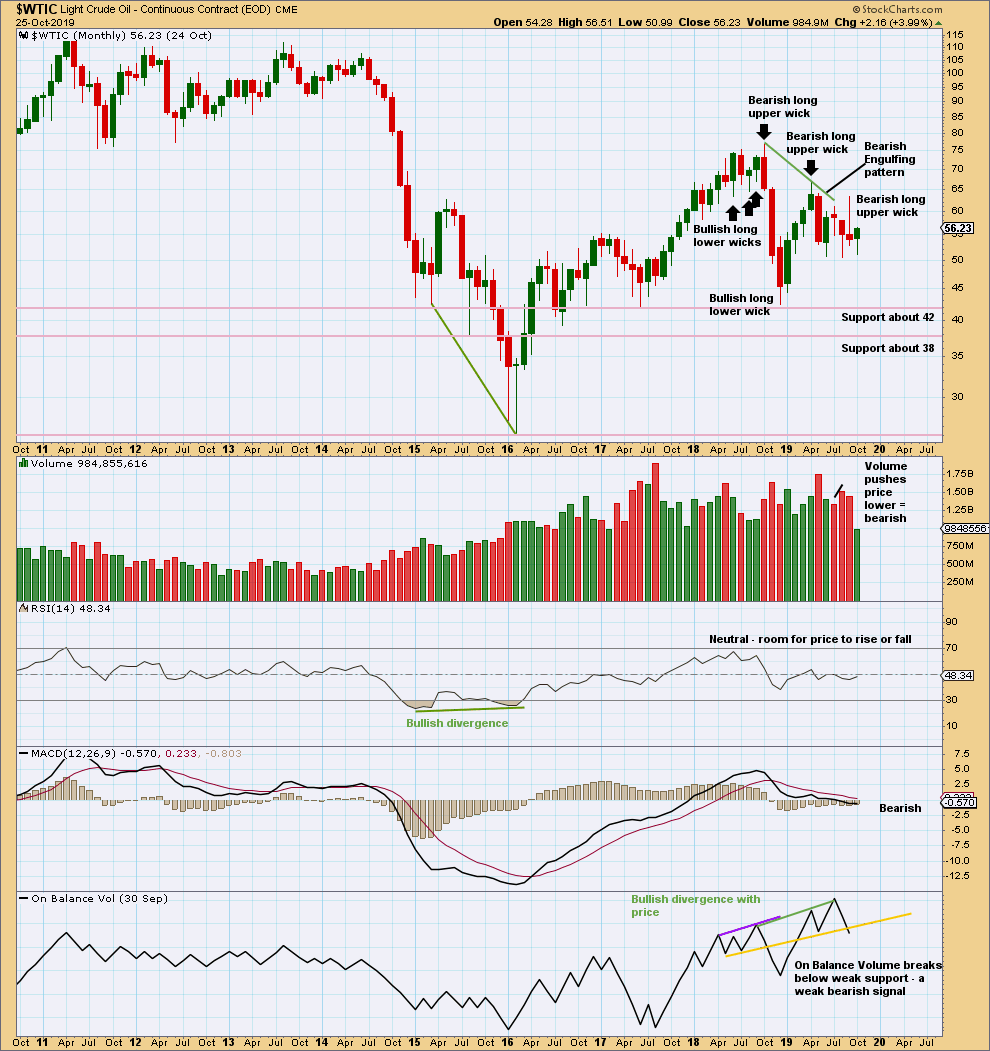
Click chart to enlarge. Chart courtesy of StockCharts.com.
September has closed with a very long upper wick. This is very bearish. This supports the main Elliott wave count.
There is now double bullish divergence between price and On Balance Volume. This supports the alternate Elliott wave count.
WEEKLY CHART
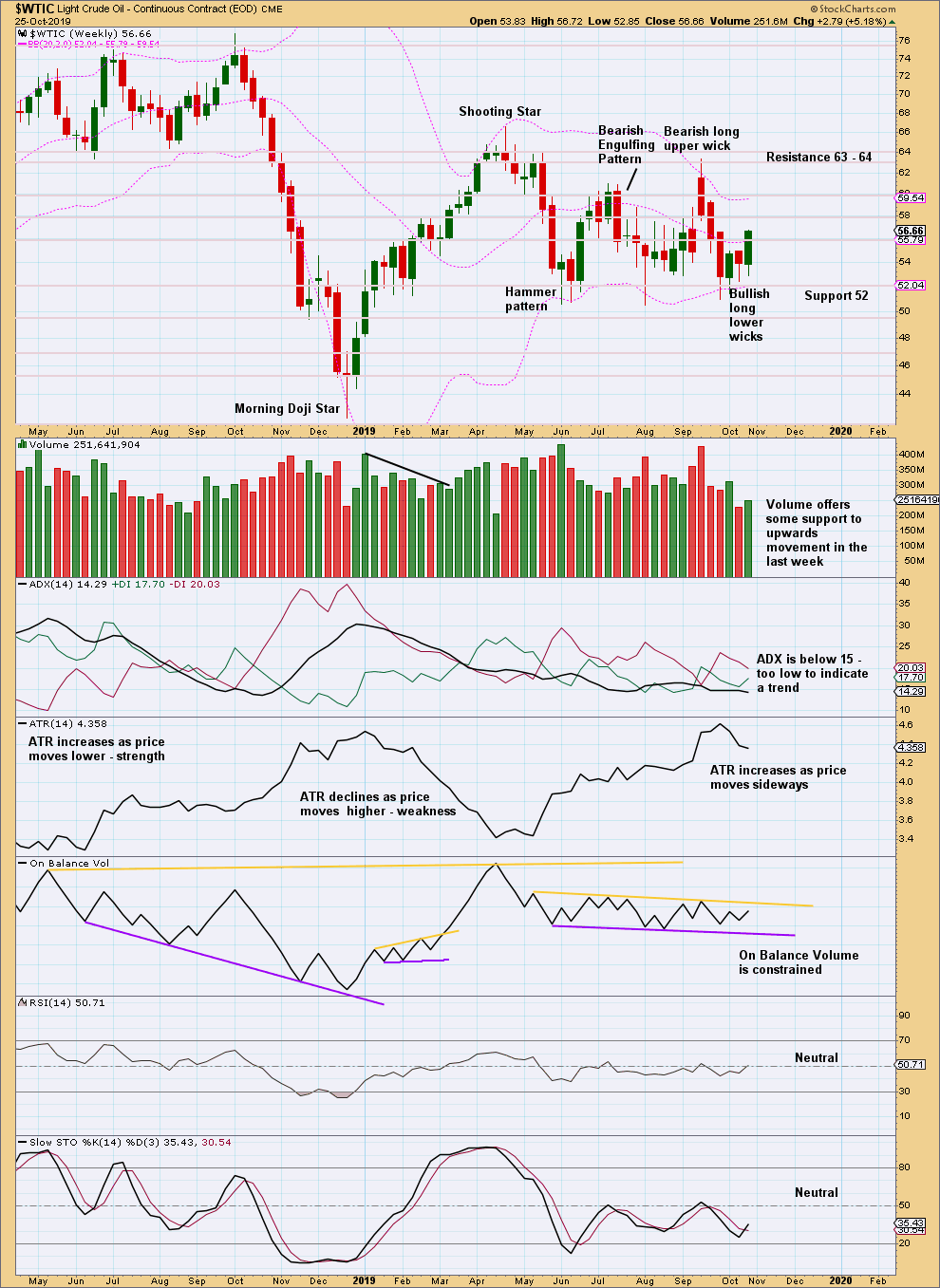
Click chart to enlarge. Chart courtesy of StockCharts.com.
Price is back within a consolidation zone with resistance about 64 and support about 50. On Balance Volume is also range bound. A breakout is required for confidence in a new trend.
This week a strong bullish candlestick with some support from volume, a longer lower wick, and a close near the high for the week suggest more upwards movement next week. This supports the Elliott wave analysis. Upwards movement may be limited by resistance for On Balance Volume.
DAILY CHART
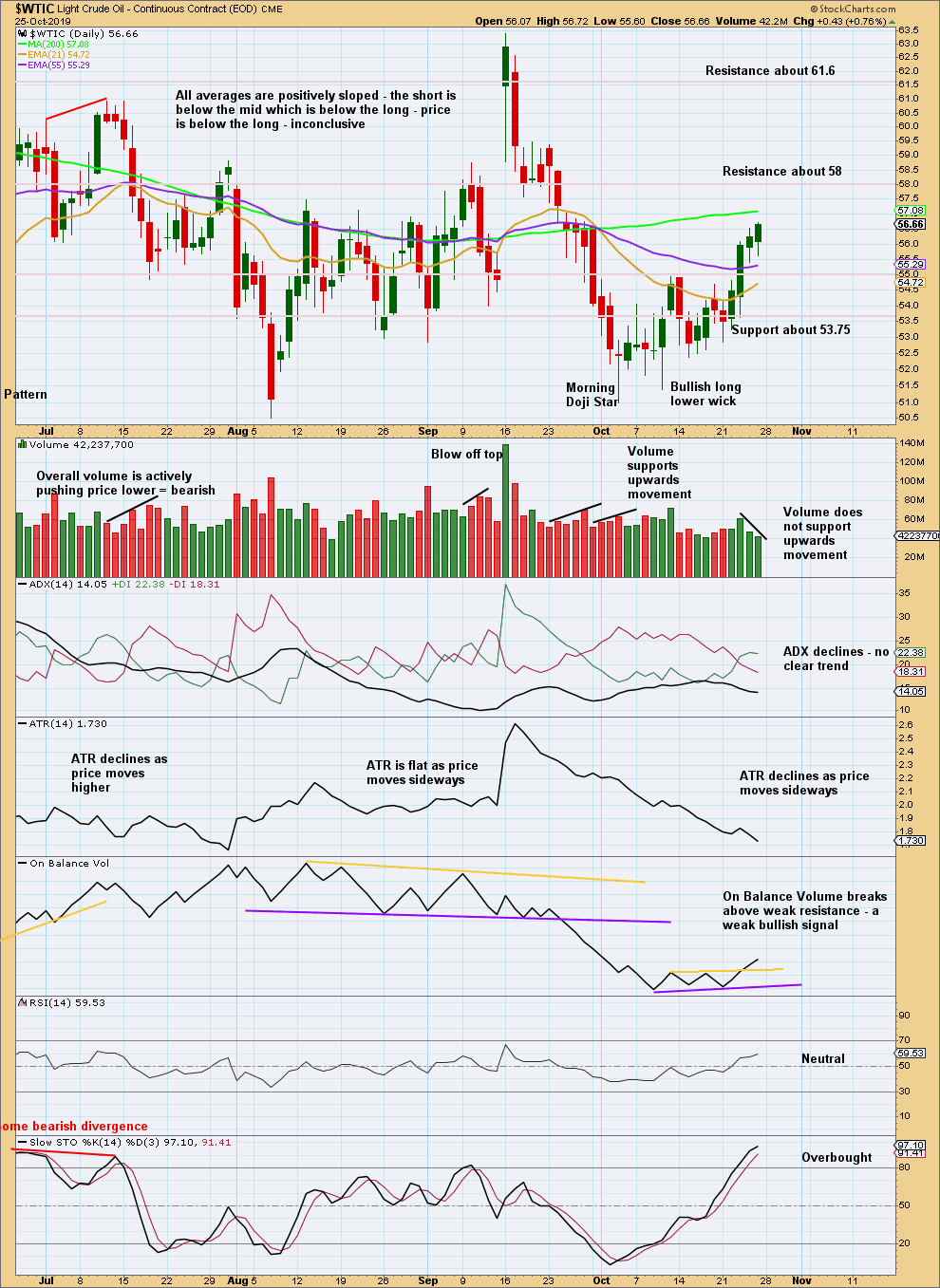
Click chart to enlarge. Chart courtesy of StockCharts.com.
For the very short term, look out for a pullback within the upwards swing. Thursday and Friday have developed some weakness with declining ATR and weakening volume while Stochastics has reached overbought.
—
Always practice good risk management as the most important aspect of trading. Always trade with stops and invest only 1-5% of equity on any one trade. Failure to manage risk is the most common mistake new traders make.

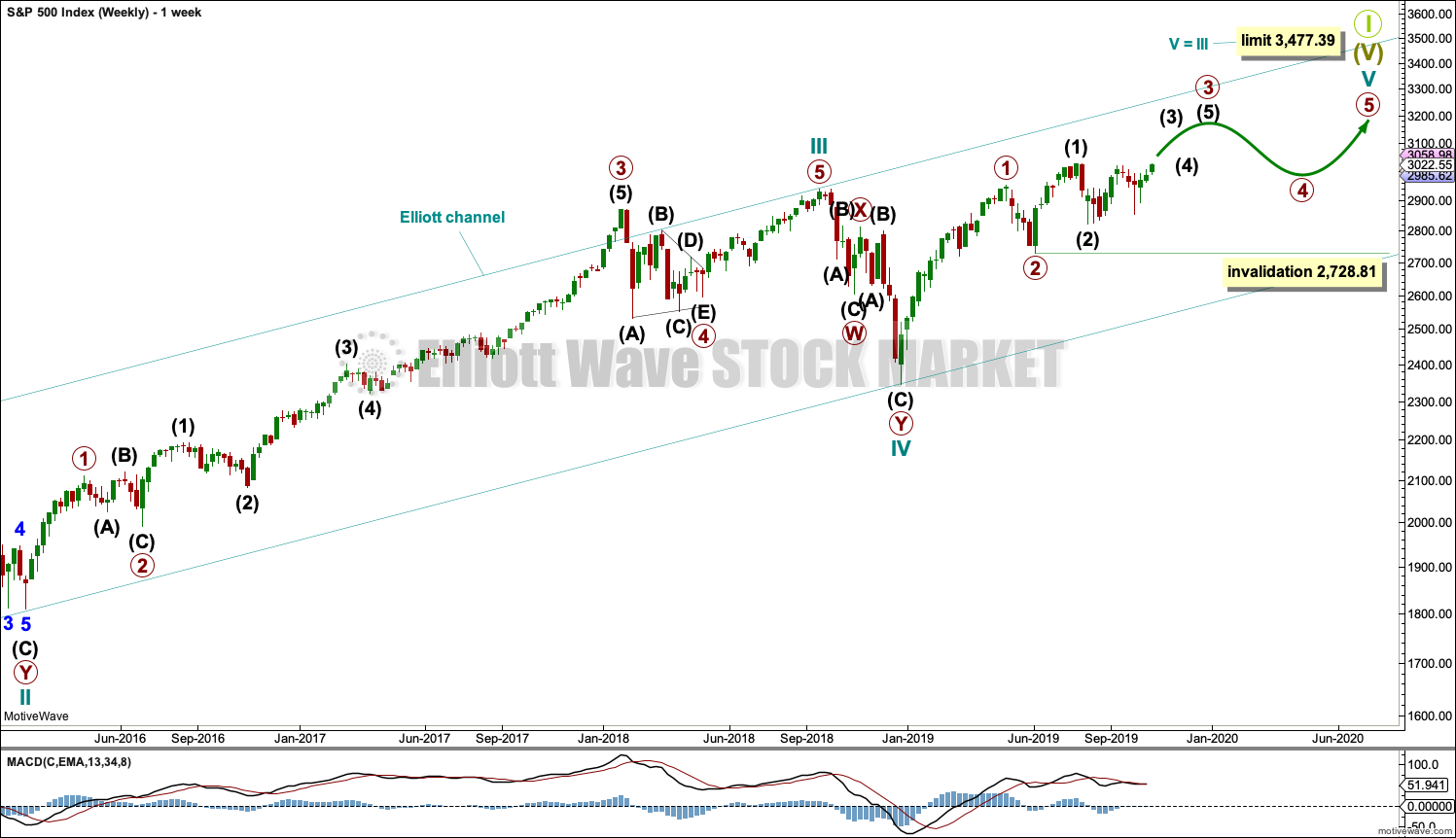
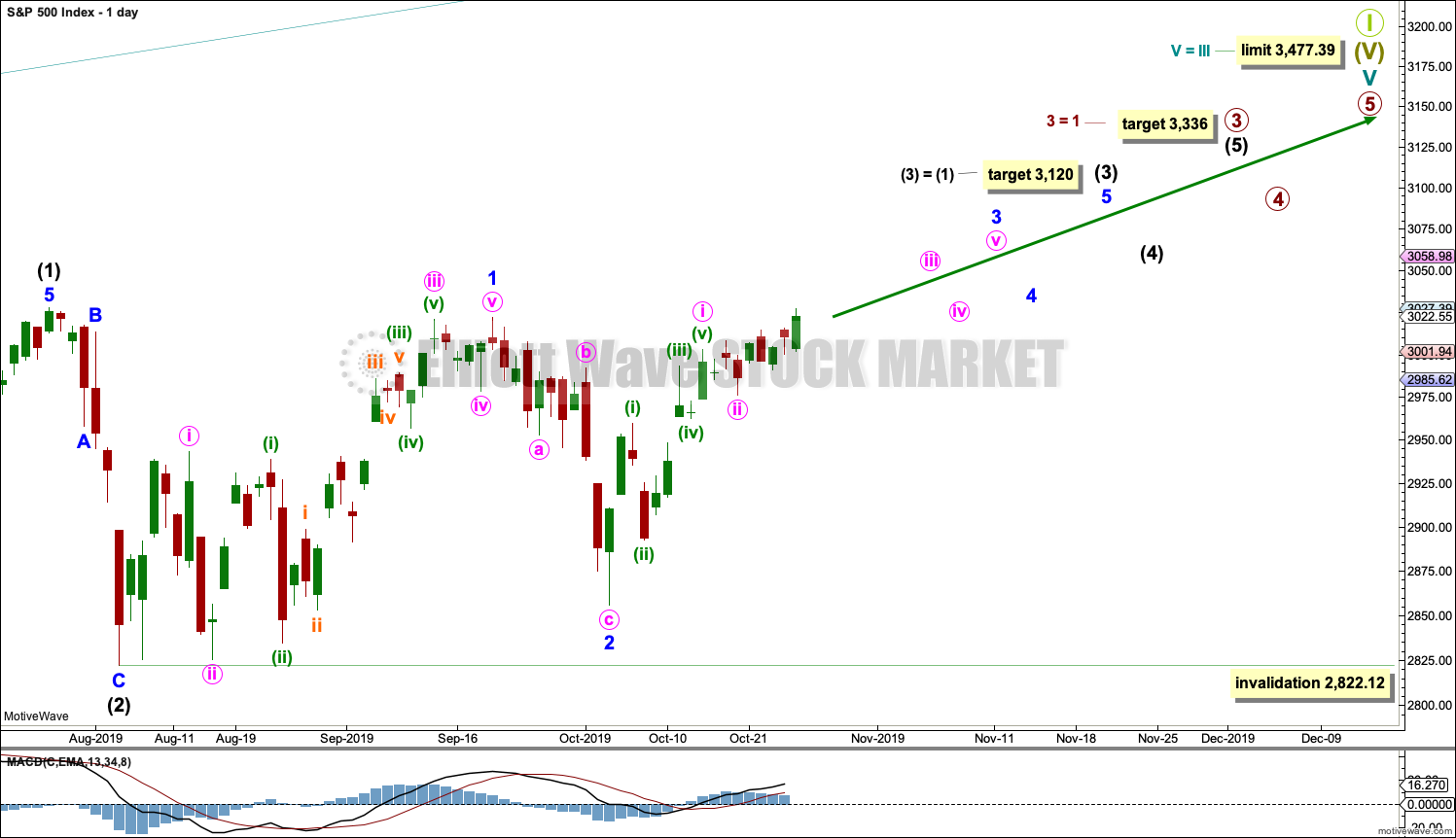
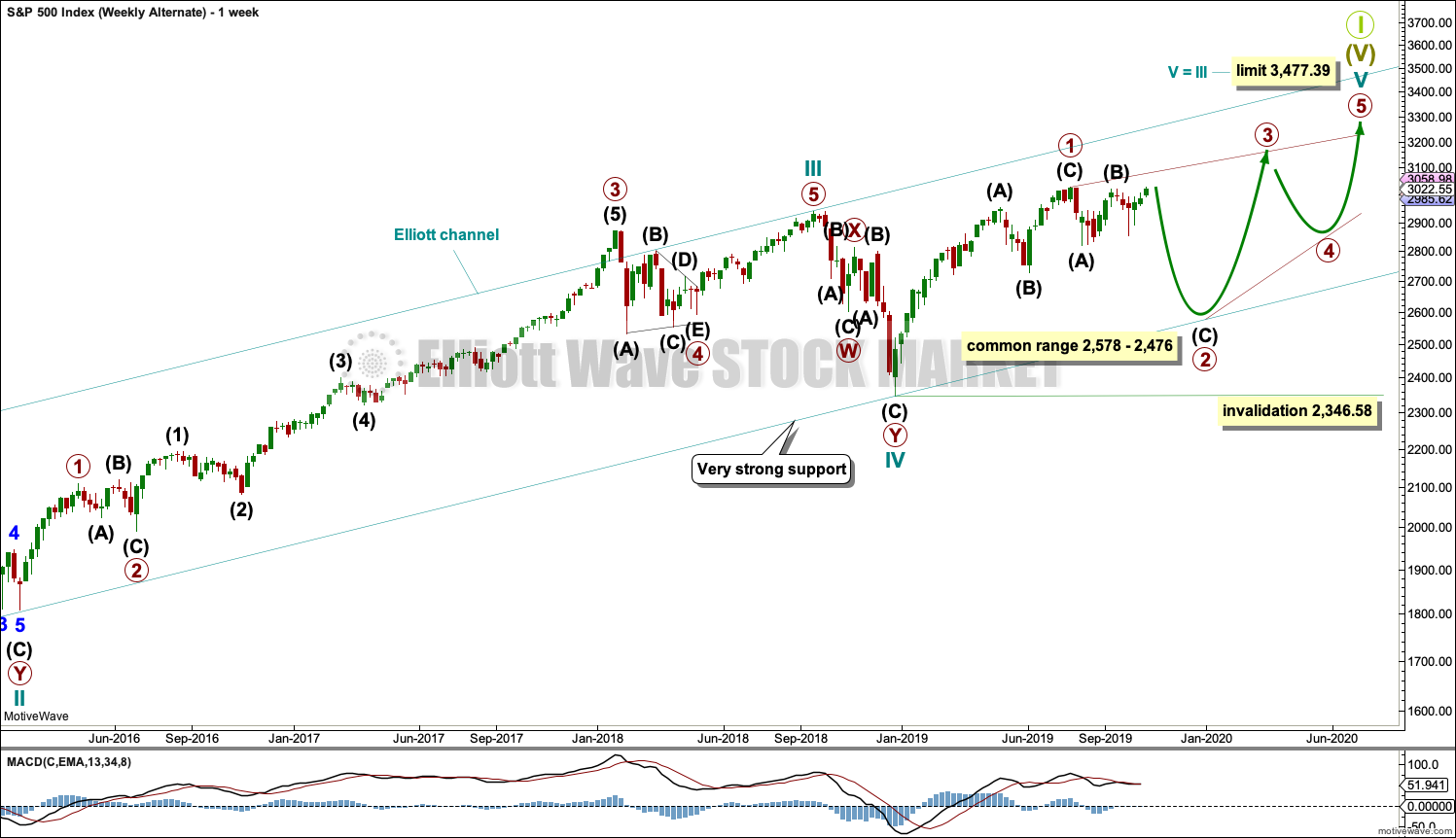
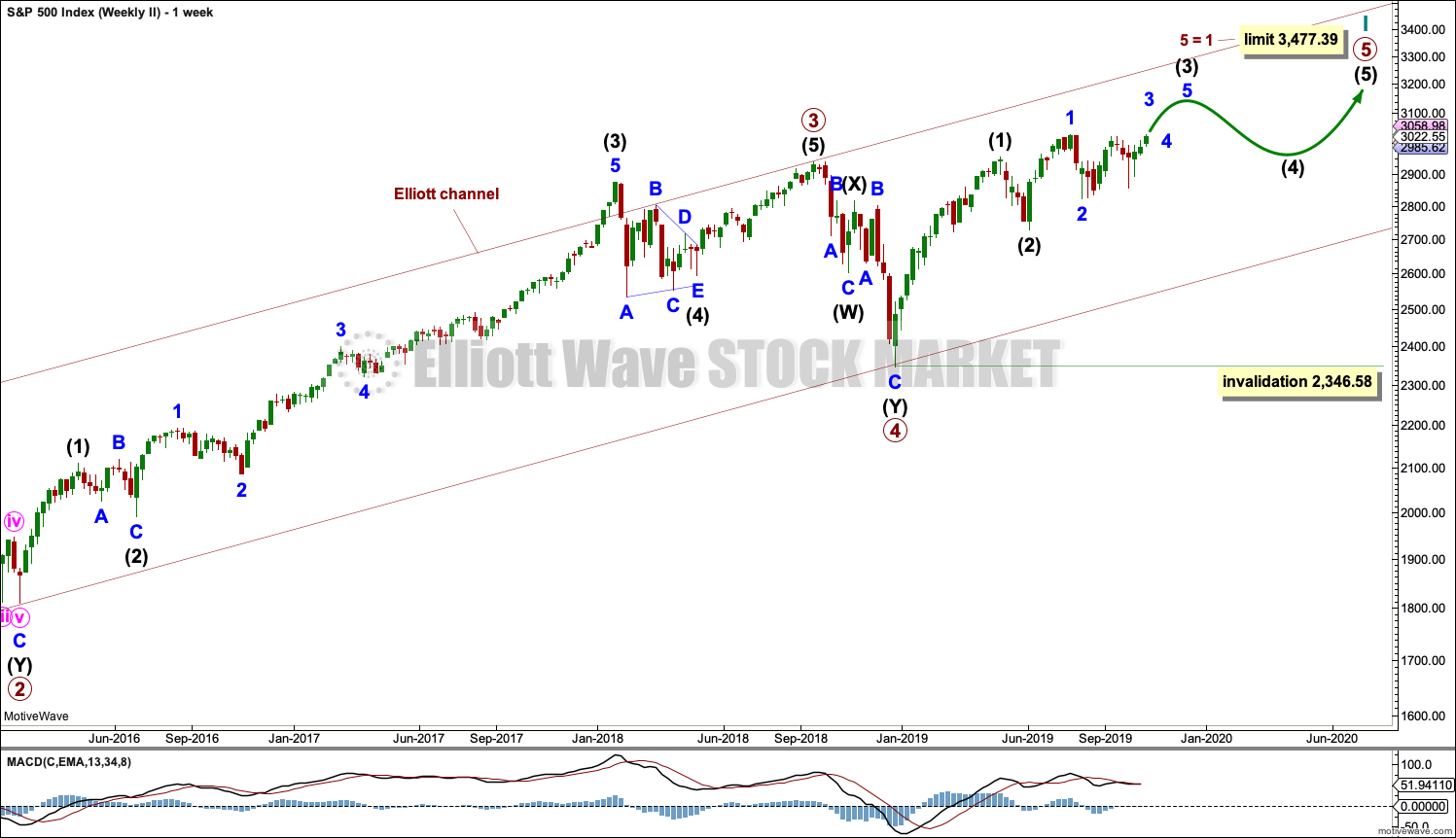
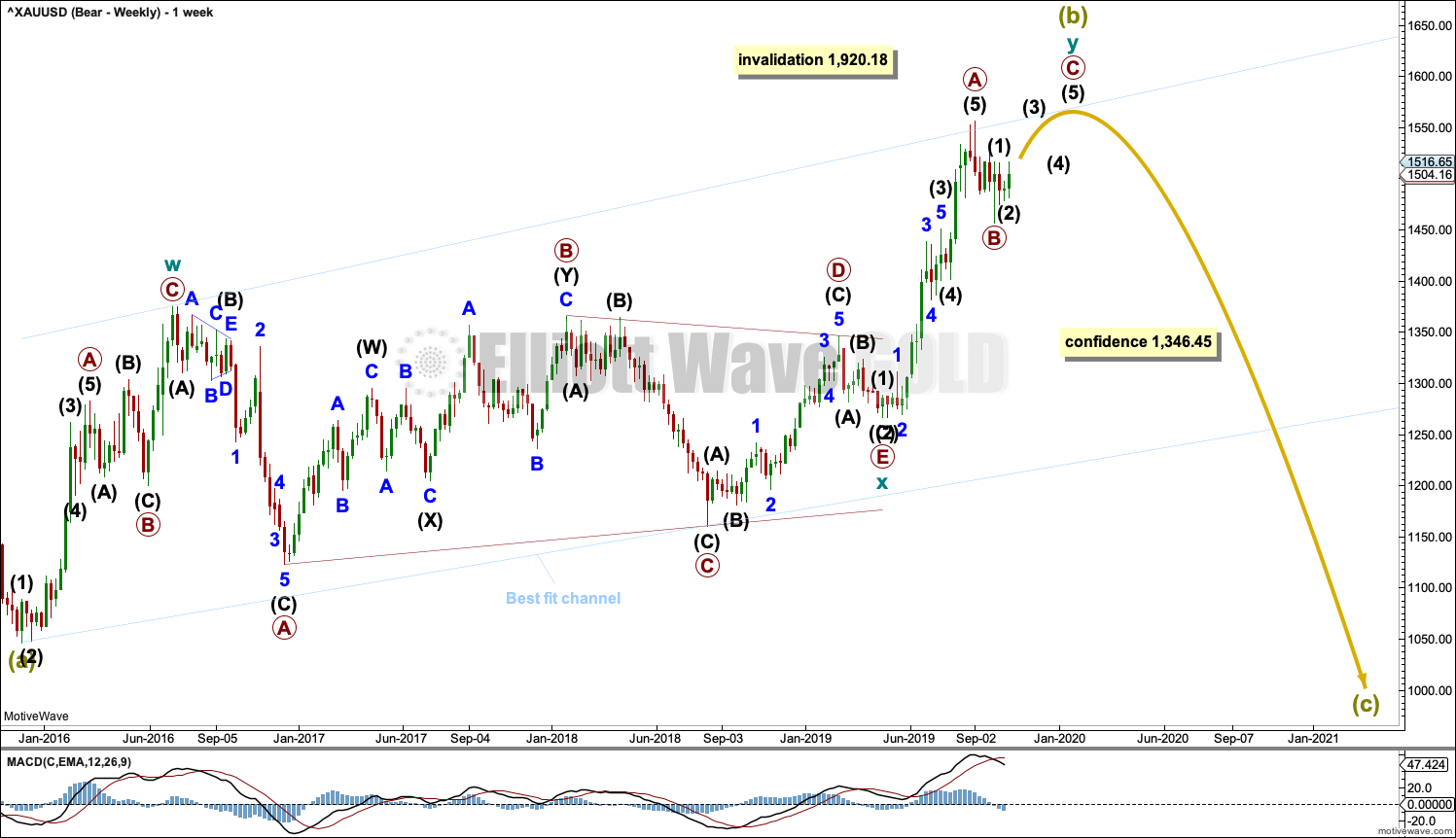
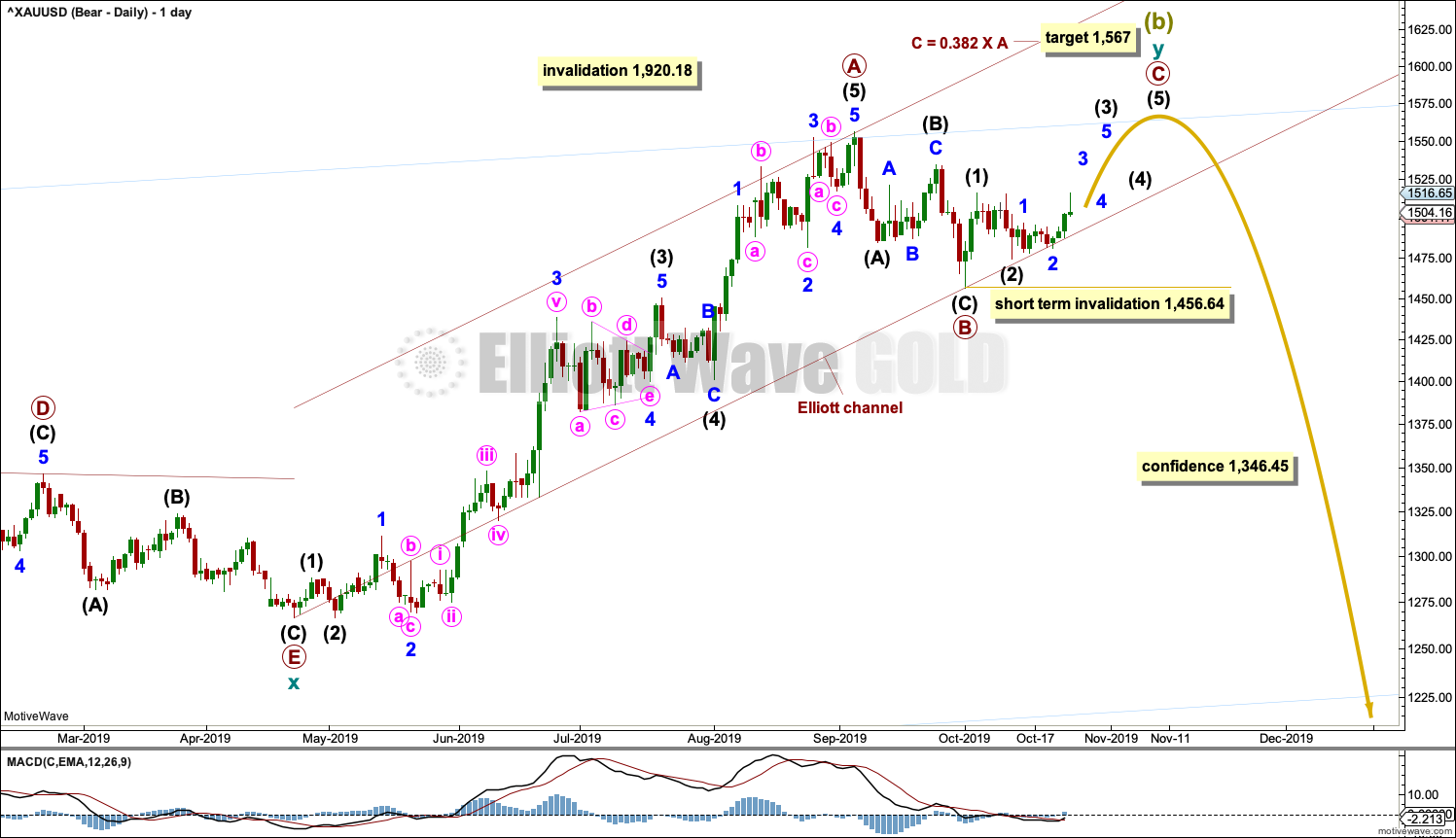

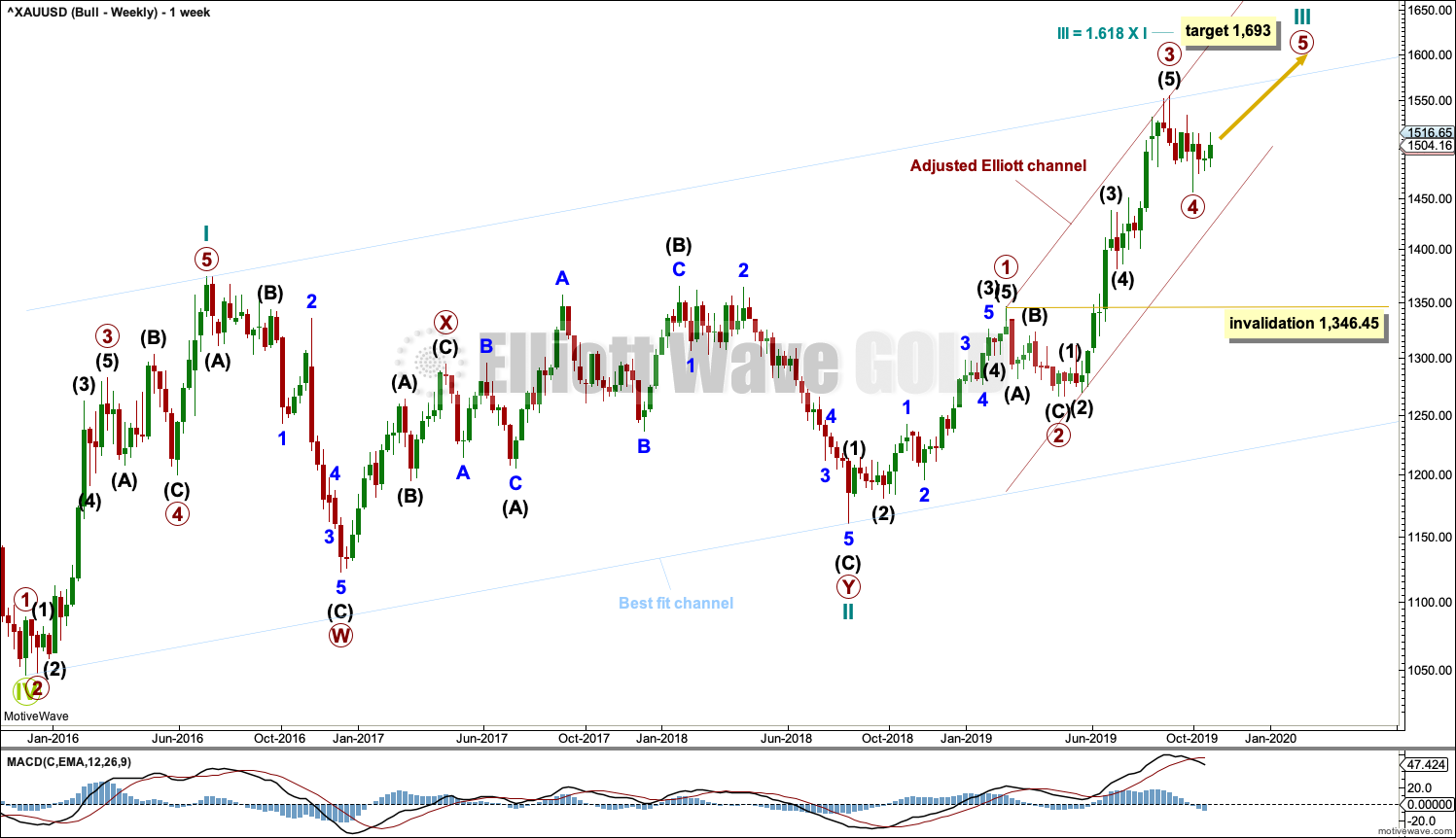


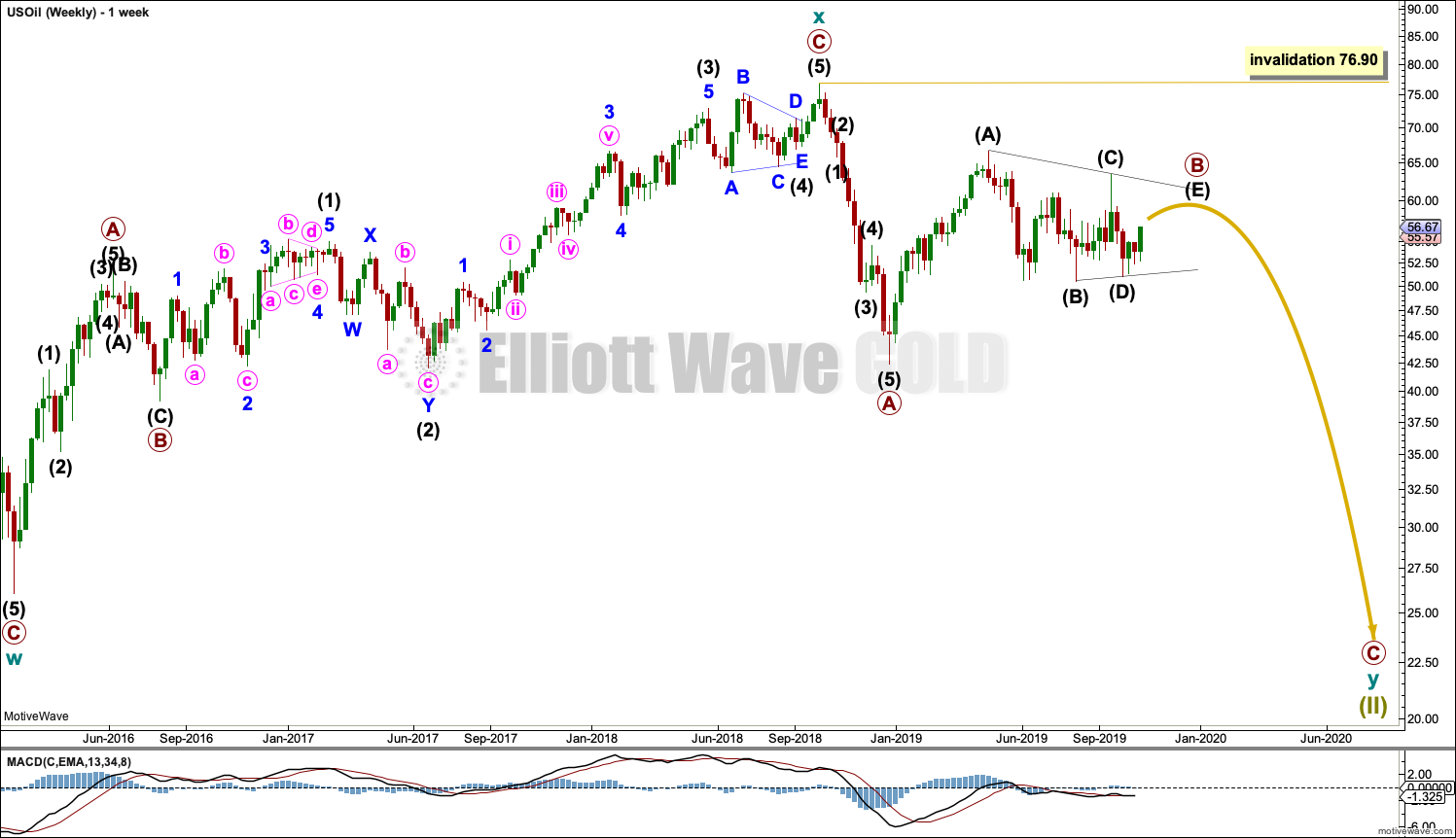
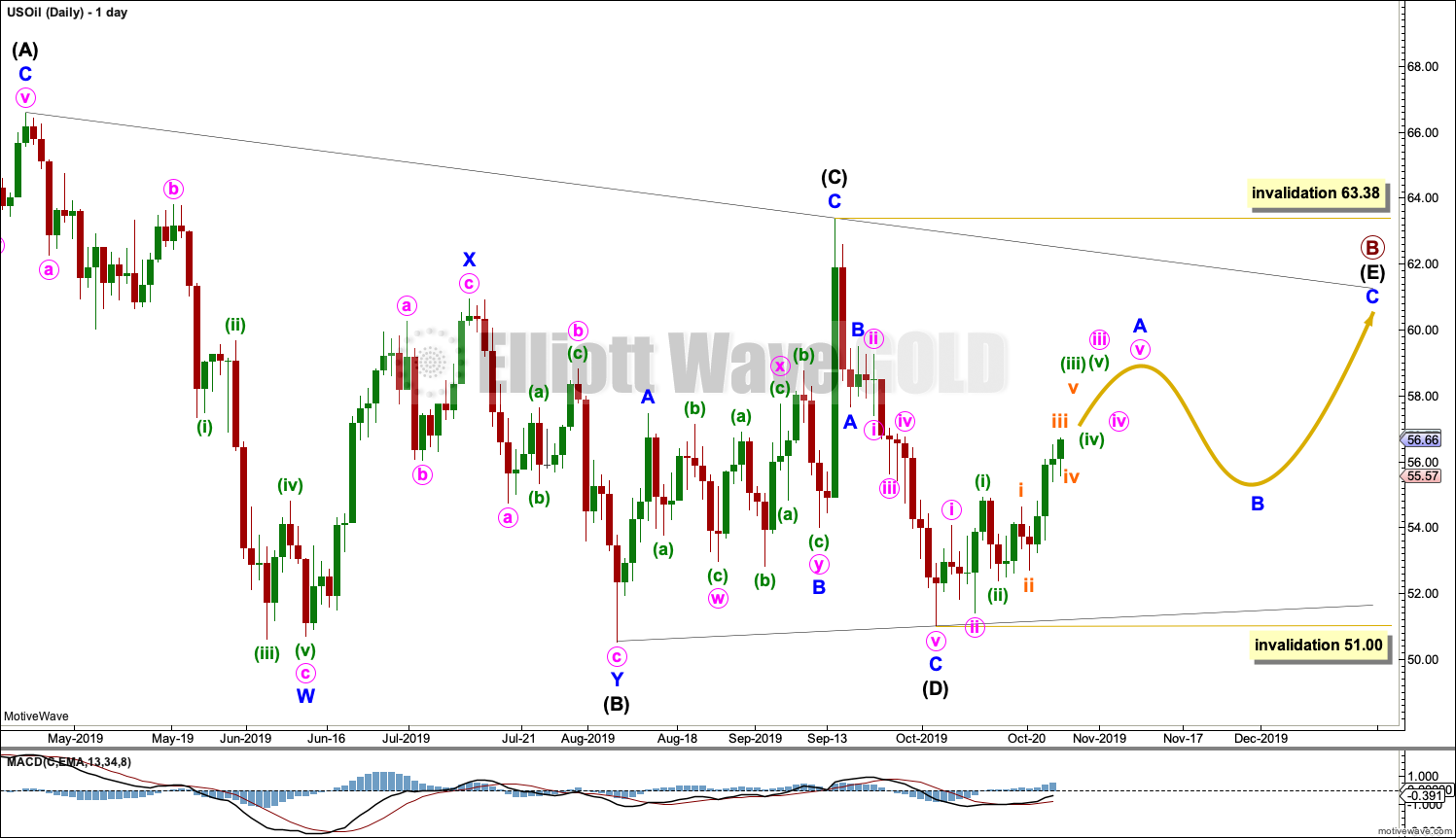
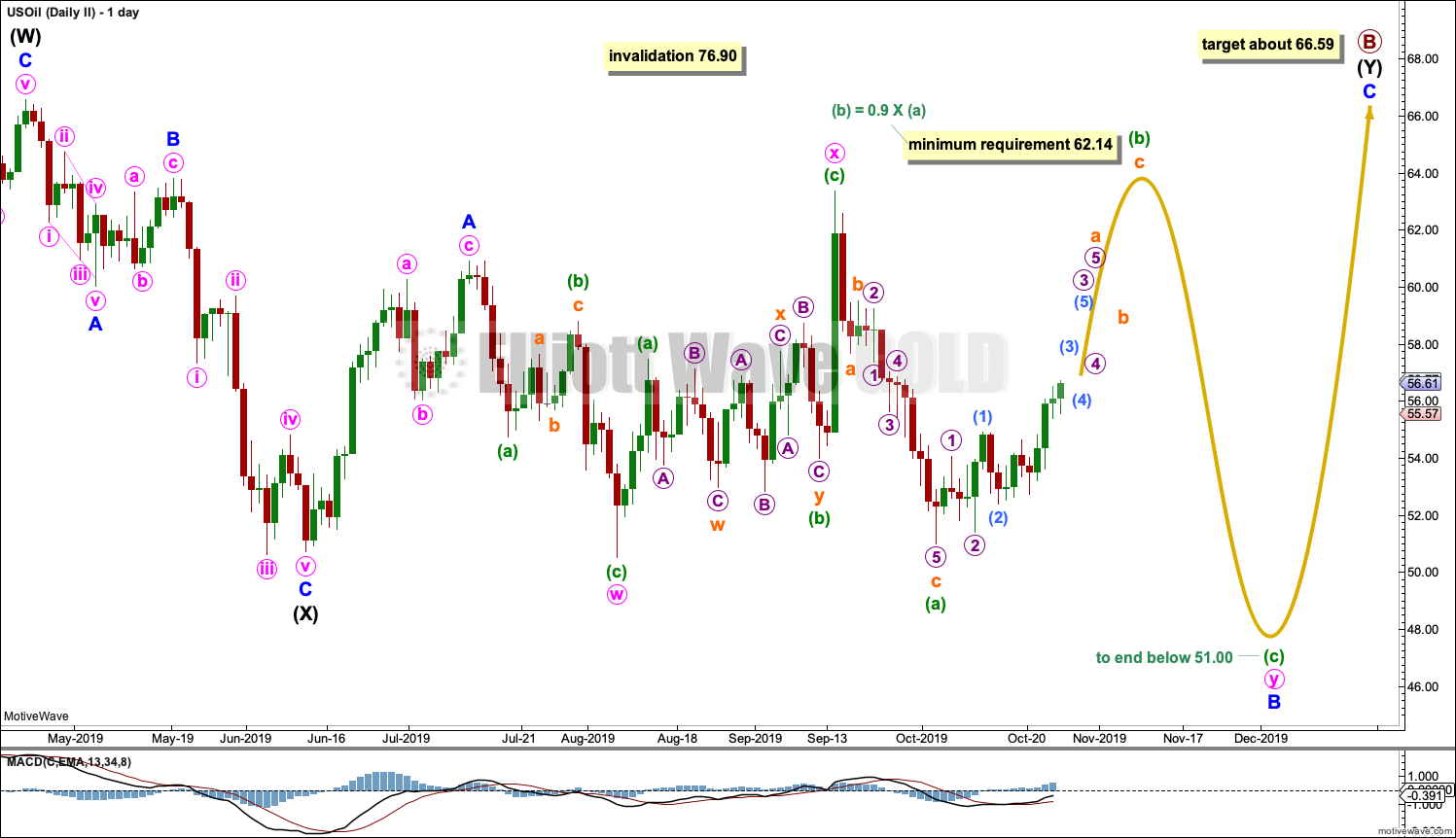
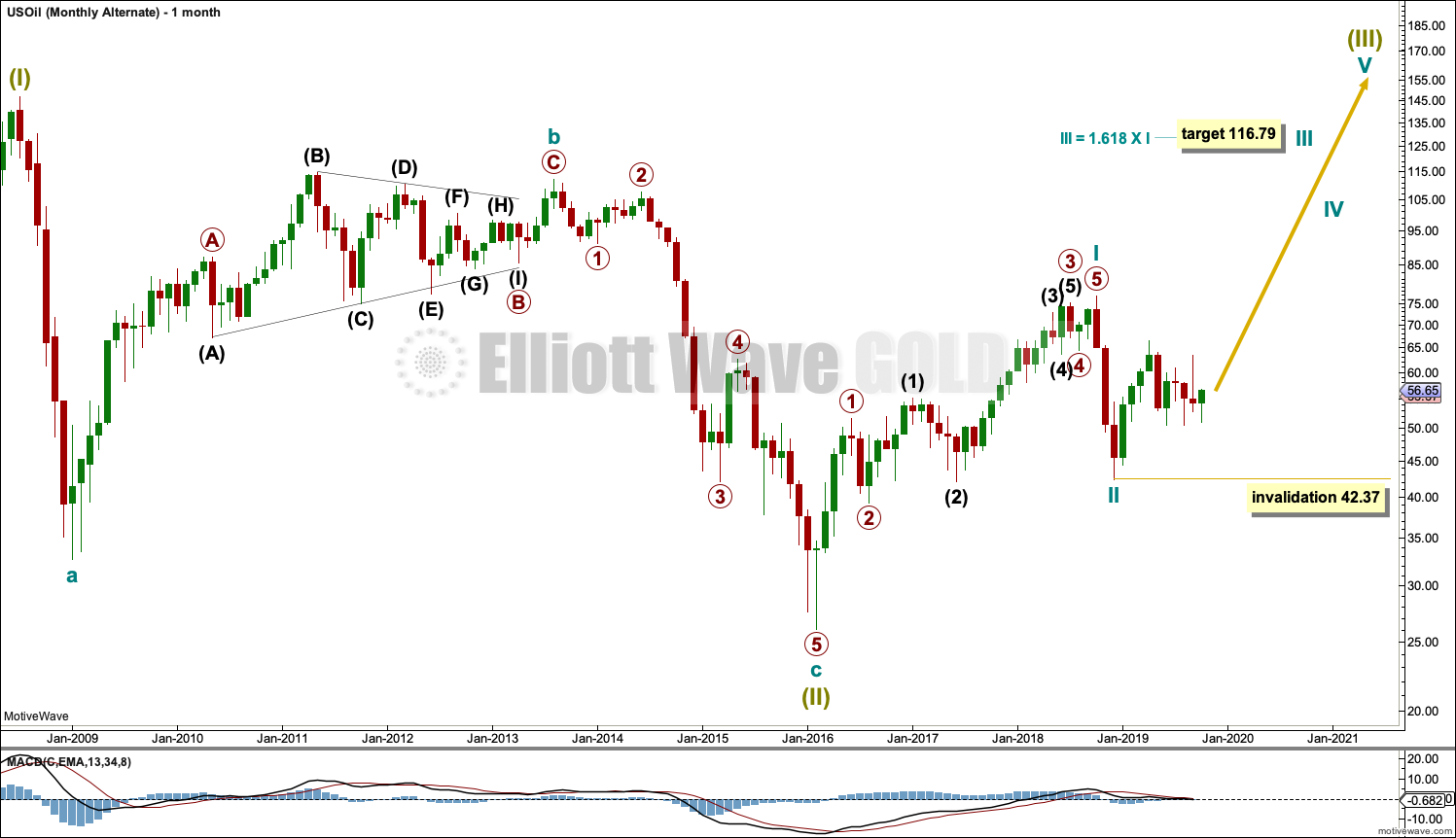
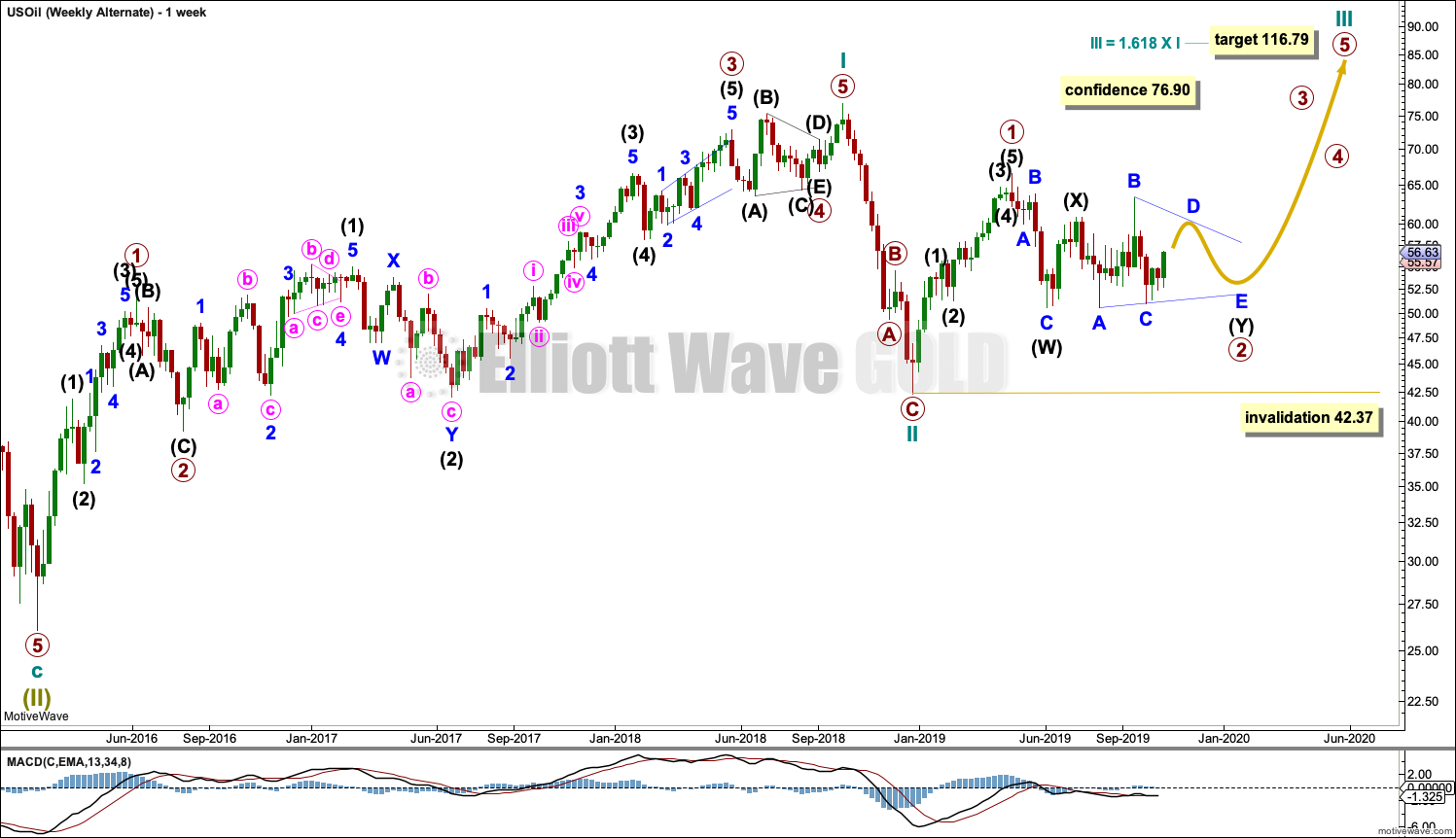
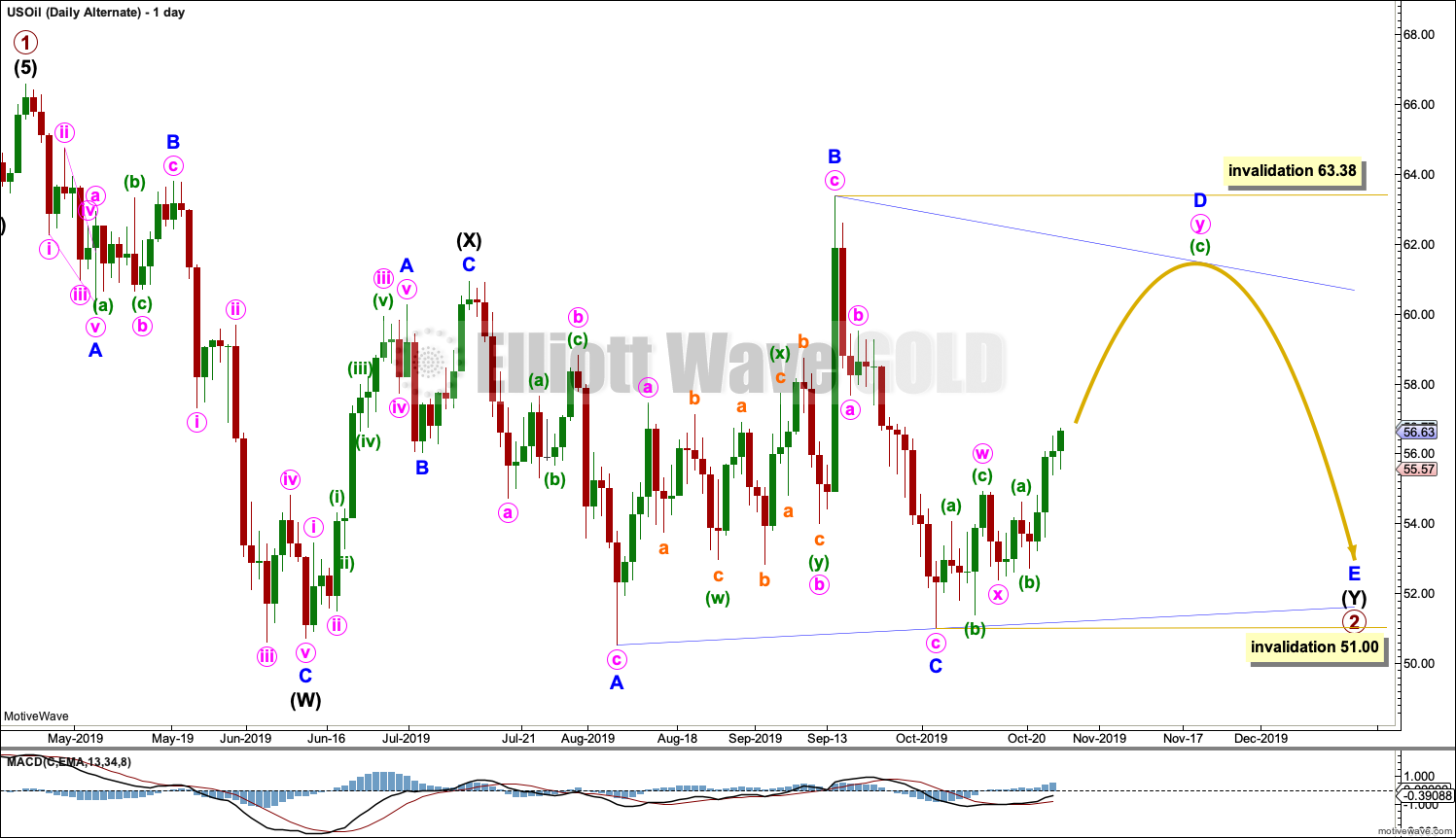
Lara, With USOIL prices moving down into Minute i territory are we already in Minor B of you primary count? If so, Minor A doesn’t look like an impulse to me. Your guidance is appreciated.
Minor A may be a leading expanding diagonal.
If that’s correct, then minute v of the diagonal should be longer than minute iii. That would be achieved at 58.24 (if minute iv is over and does not move any lower that is)
I can’t see a complete structure for minor A yet, I don’t think this downwards move is minor B.
Thanks, I hadn’t thought of that possibility for Minor A.
Lara, Sorry but where are the Bitcoin posts located?
Never mind. I found it. 🙂
Lara
Based on S&P action on Monday October 28th, is the diagonal alternate still viable
Thanks
Rich
No, it’s invalidated.
The S&P500 gapped up to make a new all time high on the 28th of October. That gap may be a breakaway gap and so may not be closed. Use it for support now at 3,027.39.
There may be some consolidation here before price moves up and away.
Only the main Elliott wave count remains valid for the S&P. The structure of this third wave is incomplete. There will be corrections / pullbacks (little fourth waves) along the way up, but overall I’m still expecting price to keep going up.
Hi Lara, Bitcoin seems to have found an important low near $7400 as price has surged over 3,000 to $10,500 before pausing. Any chance for an update this week?
I’ll be updating Bitcoin charts in the comments of the last Bitcoin post later today
Good day Lara. Thanks for the analysis and commentary. I notice that you show a monthly chart in the technical analysis section for both gold and oil. I am wondering if you wouldn’t mind showing this on SPX once in a while, say just after the end of a month. Just a thought and suggestion to consider.
Have a great weekend.
Rodney
Good idea Rodney. Will try and remember this…
Would be good to have an updated monthly TA at the beginning of each new month.